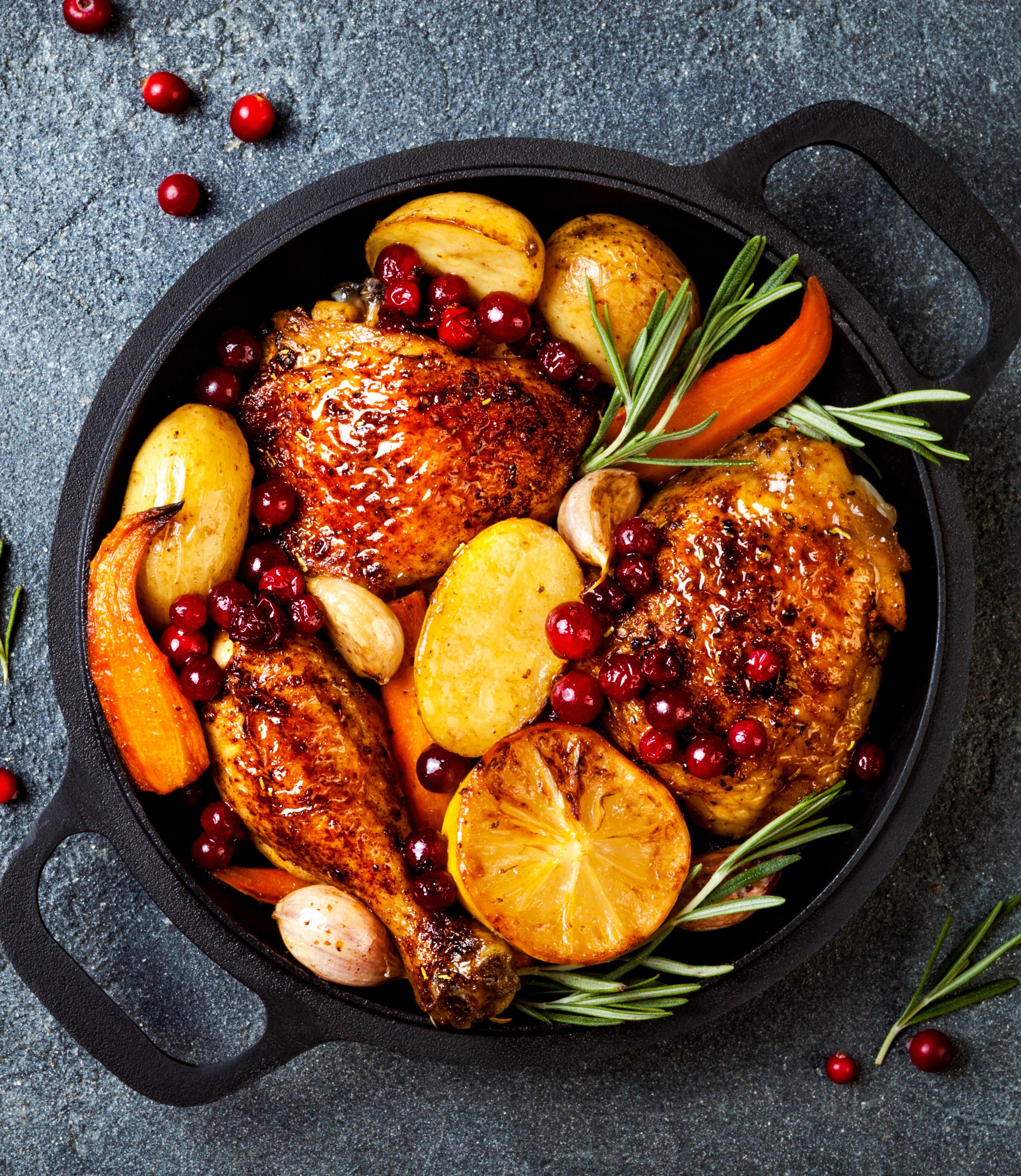
SURVIVING BY A TRICKLE meatbusinesspro.com $7.99 THE BEEF, PORK & POULTRY INDUSTRY DIGITAL MAGAZINE November 2022 U.S. Meat Sector Releases First-Ever Data Report on Environment FCC: 2022 Cattle and Hogs Outlook Update A Canadian Startup is Disrupting the Meat Industry Doug Easterbrook named Ontario’s Finest Butcher USask Announces Food Industry Management Degree

2 MEATBUSINESSPRO November 2022 meatbusinesspro.com https://www.yesgroup.ca

5 6 12 15 16 Montana's Joins the Canadian Roundtable for Sustainable Beef Surviving by a Trickle FCC: 2022 Cattle and Hogs Outlook Update U.S. Meat sector releases first-ever data report on environment, other key indicators WMIN Announces 2022 Most Impactful Woman November 2022 A Canadian Startup is Disrupting the Meat Industry Satellite Smartphones Could Eventually Answer the Call for Rural Connectivity Doug Easterbrook named Ontario’s Finest Butcher USask Announces New Food Industry Management Degree U.S. Supreme Court to Rule on Pork Industry Challenge to California Law 18 20 22 24 26

https://www.reiser.com
Meat
We Communications West Inc. 106-530 Kenaston Boulevard Winnipeg, MB, Canada R3N 1Z4
Phone: 204.985.9502 Fax: 204.582.9800 Toll Free: 1.800.344.7055
E-mail: publishing@meatbusiness.ca Website: www.meatbusinesspro.com
Meat Business Pro subscriptions are available for $28.00/year or $46.00/two years and includes the annual Buyers Guide issue. ©2020 We Communications West Inc. All rights reserved.
The contents of this publication may not be reproduced by any means in whole or in part, without prior written consent from the publisher.
Montana's BBQ & Bar is a proud member of the Canadian Roundtable for Sustainable Beef (CSRB). This membership displays Montana's commitment to environmental, social and economic sustainability in Canadian beef. The brand announced that it is sourcing at least 30% of its beef from farms and ranches certified to the standards set by the CSRB.

"We are proud to partner with CRSB to support sustainable beef sourcing. Montana's aims to be a beacon of the community and find ways to minimize the impact of its business on the planet," says Adrianne Largo, Director, Marketing of Montana's. "This includes looking for new and innovative packaging solutions that align with our guiding principles for sustainable packaging."

"As a beef producer, it is wonderful to see brands like Montana's value what we do to take care of the land, our animals, and our communities every day, and to share our commitment to continual improvement as part of a thriving, sustainable food system," says Ryan Beierbach, Chair of the CRSB and rancher from Saskatchewan.
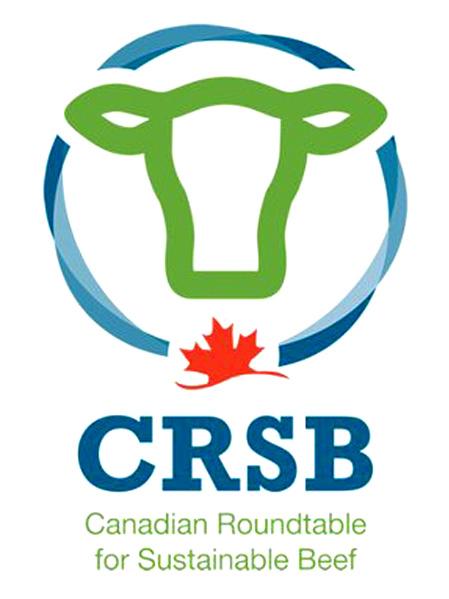
The CSRB membership is part of Montana's social responsibility journey to embrace sustainability for a better earth due to growing momentum within the Montana's brand, as well as among guests.

Montana's Great Canadian Steak Event is back and will continue until January 9, 2023, including a holiday favourite the Seasonal Steak Special. 100% AAA Canadian sirloin, aged for 50 days, marinated for eight hours, flamed-grilled to order by our certified Grill Masters, then topped with caramelized onion maple Bourbon butter sauce and served with creamy potato smashers, two crispy onion rings, and the choice of in-house baked beans or coleslaw, and finish off with cinnamon sugar-dusted donuts and spiced chocolate dipping sauce. Great steaks for a healthy planet is something Montana's is behind.
For more information, visit https://www.montanas.ca/csr
5 meatbusinesspro.com November 2022 MEATBUSINESSPRO
November 2022 Volume 26 Number 11
Business Pro is published 12 times a year by We Communications West Inc
Printed in Canada. ISSN 1715-6726 CO MMUNICATIONS W EST IN C PUBLISHER
Ray Blumenfeld ray@meatbusiness.ca MANAGING EDITOR
Scott Taylor publishing@meatbusiness.ca
DIGITAL MEDIA EDITOR
Cam Patterson cam@meatbusiness.ca
THE BEEF, PORK & POULTRY INDUSTRY DIGITAL MAGAZINE
JOINS THE CANADIAN ROUNDTABLE FOR SUSTAINABLE BEEF
CONTRIBUTING WRITERS Brendan Rolfe, Martha Roberts, Nate Raymond, Cam Patterson, Jack Roberts CREATIVE DIRECTOR Patrick Cairns
MONTANA'S
SURVIVING BY A TRICKLE
The farmer’s fight to secure water and save greenspace


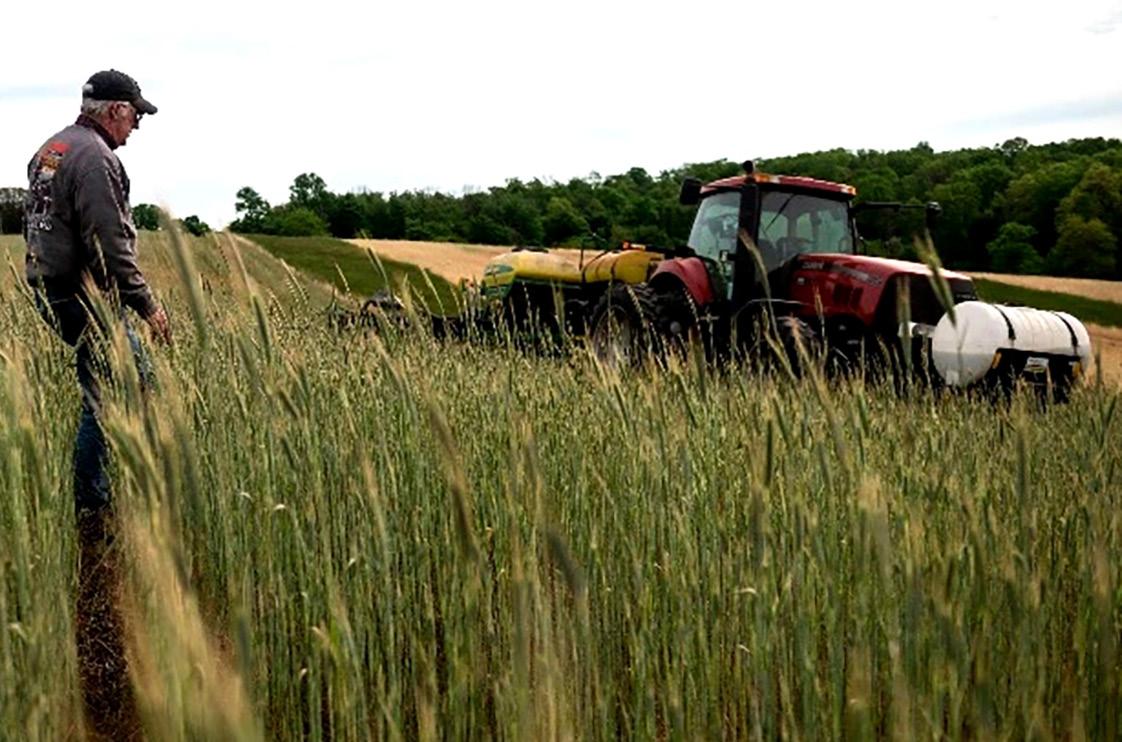
Doug Wilson is a mild-mannered, disarming, and welcoming farmer in Maple Creek, Saskatchewan. He is a bit of a throwback to a time when people were polite but told things like they were, without the coating of sugar that many of us tend to sprinkle on uncomfortable subjects today. He is the kind of guy that you could easily crack a beer with or simply take a stroll within the long grass and have an easy discussion about something important or nothing in particular.
Doug’s ranch sits adjacent to Maple Creek, on the banks of Tenaille Lake and is a beautiful green acreage; or at least, it used to be. The Wilson ranch is dying, or rather, it is being choked into a dry death by provincial diversion of a natural water source. Without the blockages impacting the water flow, this independent farming business would be able to continue thriving in the area, much like it did 140 years ago.
Way back in 1880, just 13 years after our country’s confederation, Doug’s family was fortunate enough to be issued a piece of raw land. This land was rough and wild but had a natural water source running directly beside it, giving the surrounding wetlands life and nourishing the land, making it a great location for a farm. In 1911, as a futile attempt to protect the vital water source in the area, the Federal government started issuing access permits to the various farms in the area. Doug’s family was issued permit number 14.
While the government issued these “resource-saving” permits, it also sold this land to the Province of Saskatchewan, who gave the green light to begin a 20year construction project on the upstream Junction Reservoir. This project would prove to be disastrous to this sensitive area, worsening drought conditions that ravaged Canadian farming in what we now refer to as the “Dirty 30s,” where dry weather created the “Dust Bowl” that contributed to the Great Depression of the 1930s.

6 MEATBUSINESSPRO November 2022 meatbusinesspro.com
Now fast forward 80 short years (with a lot of long days in between). That project switched hands from the Saskatchewan Watershed Authority to the federal government for “clean up,” and back again to the Saskatchewan government via the new Water Security Agency (WSA). The WSA currently has full control of water allocation in all of Saskatchewan. The WSA also boasts of having the ownership and operation rights to 72 dams across the province, making them a strong opponent to any independent opposition like Doug Wilson.

table hasn’t just dropped, it has fallen off a cliff. Doug proceeded to contact the WSA to appeal his case since his cattle depend on that water for drinking and feed. The WSA not only declined to return his flow rates back to normal levels, but they also pulled his original 1911 permit (permit number 14 that authorized water access for the ranch). Officials from the WSA cited that at the time of issue, a signature was missing making the century-old document invalid. After cancelling the permit, the WSA has denied Doug’s applications ever since.
In the early 90s Doug began to notice a significant drop in the amount of water flowing to his ranch. Consequently, studies would later show that this significant drop amounted to a whopping 76 per cent decrease. Added to that is the fact that Doug’s ranch sits on a natural floodplain, which would replenish the stored groundwater level each year; in essence the land irrigated itself. But without the flooding, the water


“Over the last 20 years I have spent about $250,000 trying to fight this while at the same time losing about $500,000 per year in revenue, but the Saskatchewan government has not budged. Still, I am not going to give up. The survival of my farm and the land around it depends on it.”
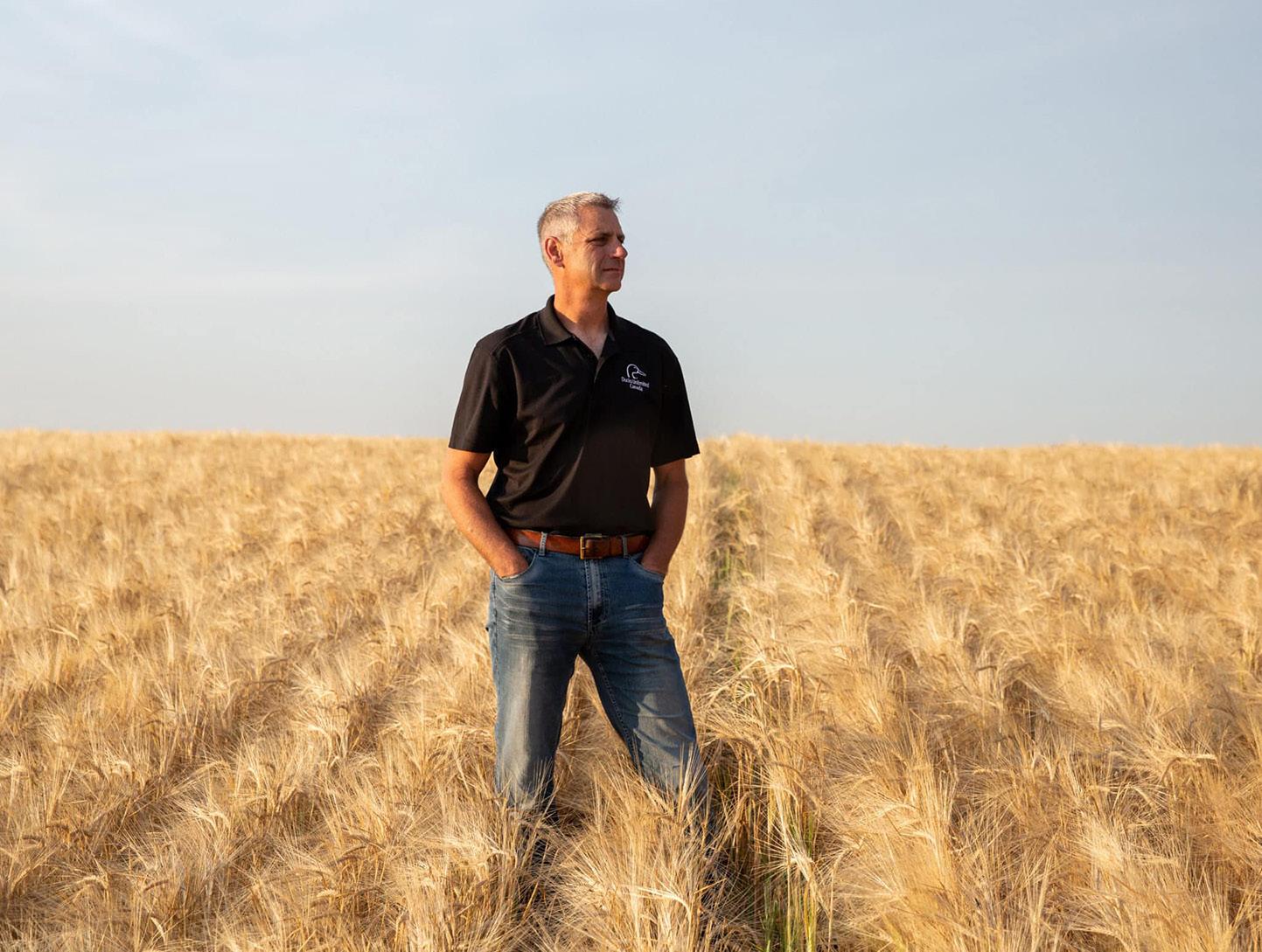
7 meatbusinesspro.com November 2022 MEATBUSINESSPRO
Continued on page 8
Doug has significant concerns about the effect that these many years of limited water in the area have had on the plants and animals that depend on that waterflow. Trees and feed-grass have been replaced by Fox Tail grass, whose spikes get stuck in cows throats and can result in them having to be put down. Dust has begun to kick up and settle on a whim, coating everything in the area. In addition, Doug has noticed that sensitive and endangered species of animals that used to thrive in the surrounding wetlands are disappearing at an alarming rate. Not only is Doug’s ranch and livelihood at risk from this governmentcaused water shortage, but so is the natural ecosystem of the area.
Potable water shortage for its many heads of cattle is not the only challenge the Wilson ranch is facing. The skyrocketing prices of livestock feed is costing Doug half a million dollars just to feed the cattle he has left and make sure they make it through the winter.


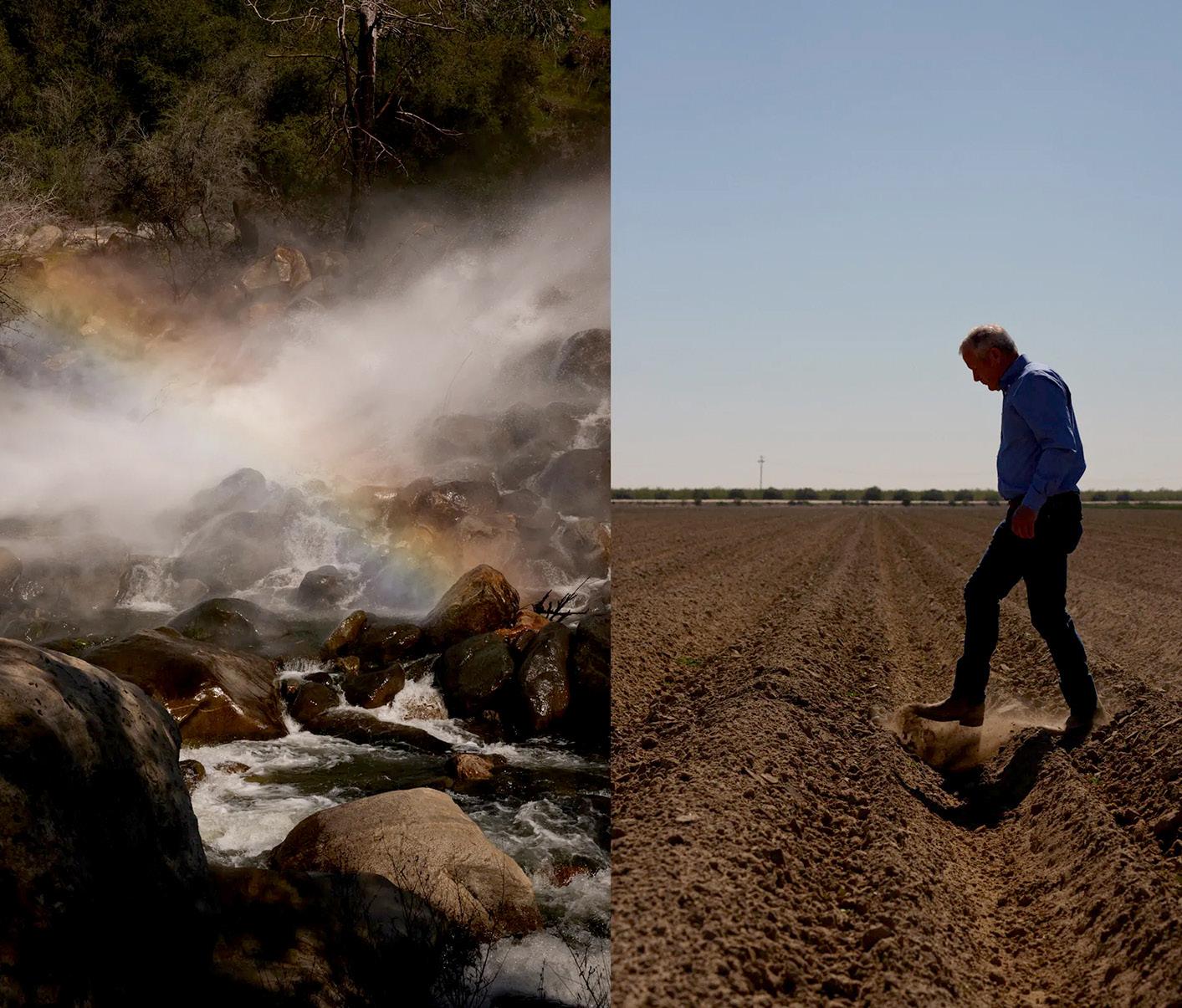
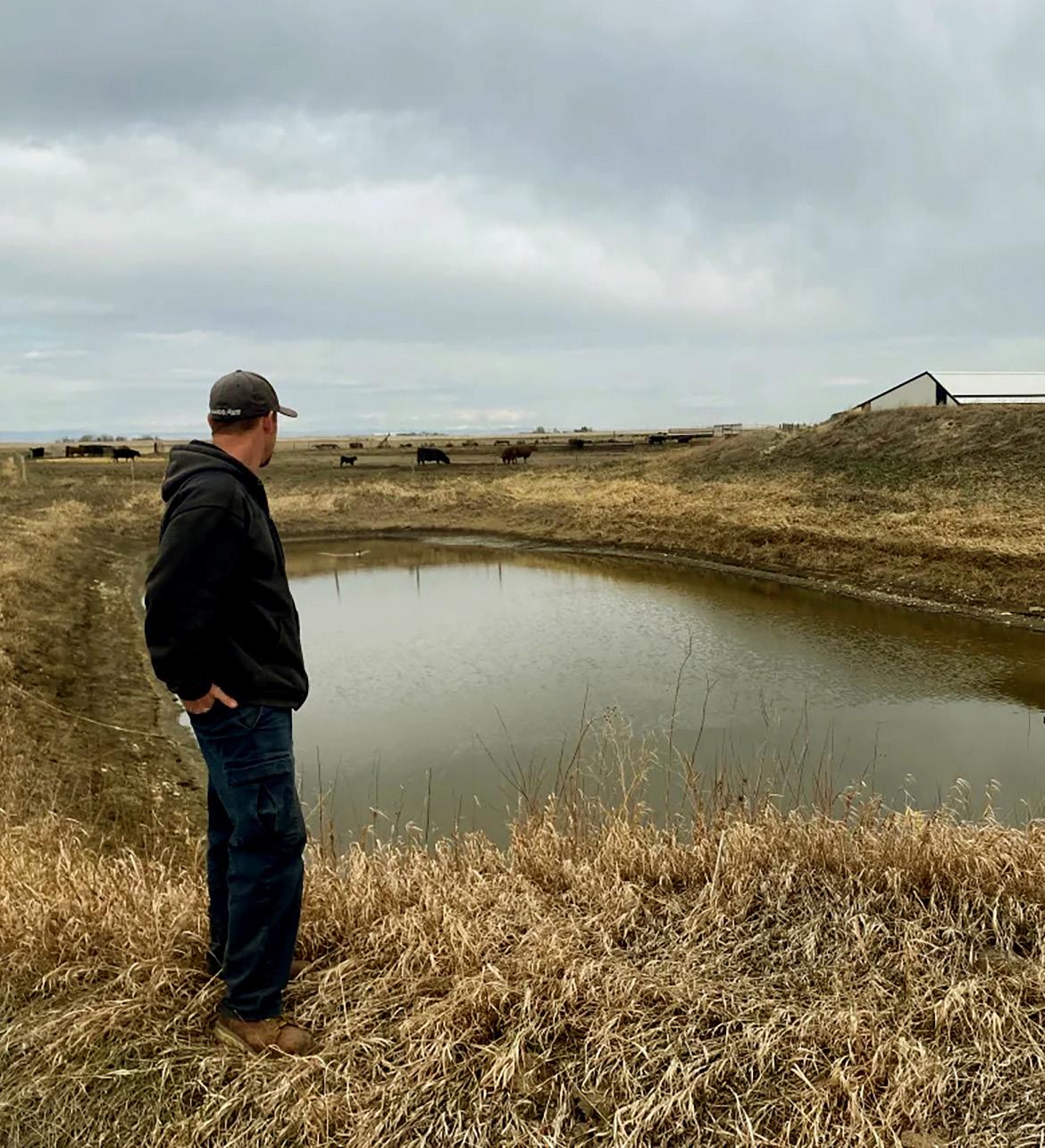
“What people don’t realize is that this is all public land, and it’s being destroyed, at the cost of the plants and animals around it. For example, it is right in the middle of the North American Fly-Way and offered a critical resting and refueling spot for migratory birds. This is bigger than me and my ranch. Farmers need to work WITH the land, if we don’t, our livelihood dies with it.”
Things may look bleak, but Doug’s farming roots and love of the land run deep. He is not afraid of hard work and certainly not afraid to fight for his livelihood and on behalf of the land around him. Doug has spent the last few years trying to work with the WSA, appealing to reason and hiring scientists to study the watershed. Our humble rancher has also been contacting other agencies who might be able to help, such as his local MLA and the federal government, whose mandate it is to protect endangered species and sensitive plant life. Although putting in the effort to get the help and solutions he needs, Doug has been forced to take his plight to the provincial court.
8 MEATBUSINESSPRO November 2022 meatbusinesspro.com
https://www.beaconmetals.com

“It really seems like everyone is afraid of the WSA. I have appealed to the federal government, my provincial government representatives, and even other environmental interest groups. They either refuse to come look at the damage with their own eyes (because then they will have to take action), or they commiserate but state they need to ‘pick their battles.’ What the WSA is doing here is illegal. But there is zero oversight and enforcement. They are damaging the environment and playing God with the natural waterways. Everyone knows it but they are choosing to look the other way.”
Doug is not opposed to government initiatives that would protect the watershed and believes in the need for proper water stewardship in agriculture. This is very important especially in areas like the Great Sand Hills, where the encroaching sand threatens to swallow up fertile earth.
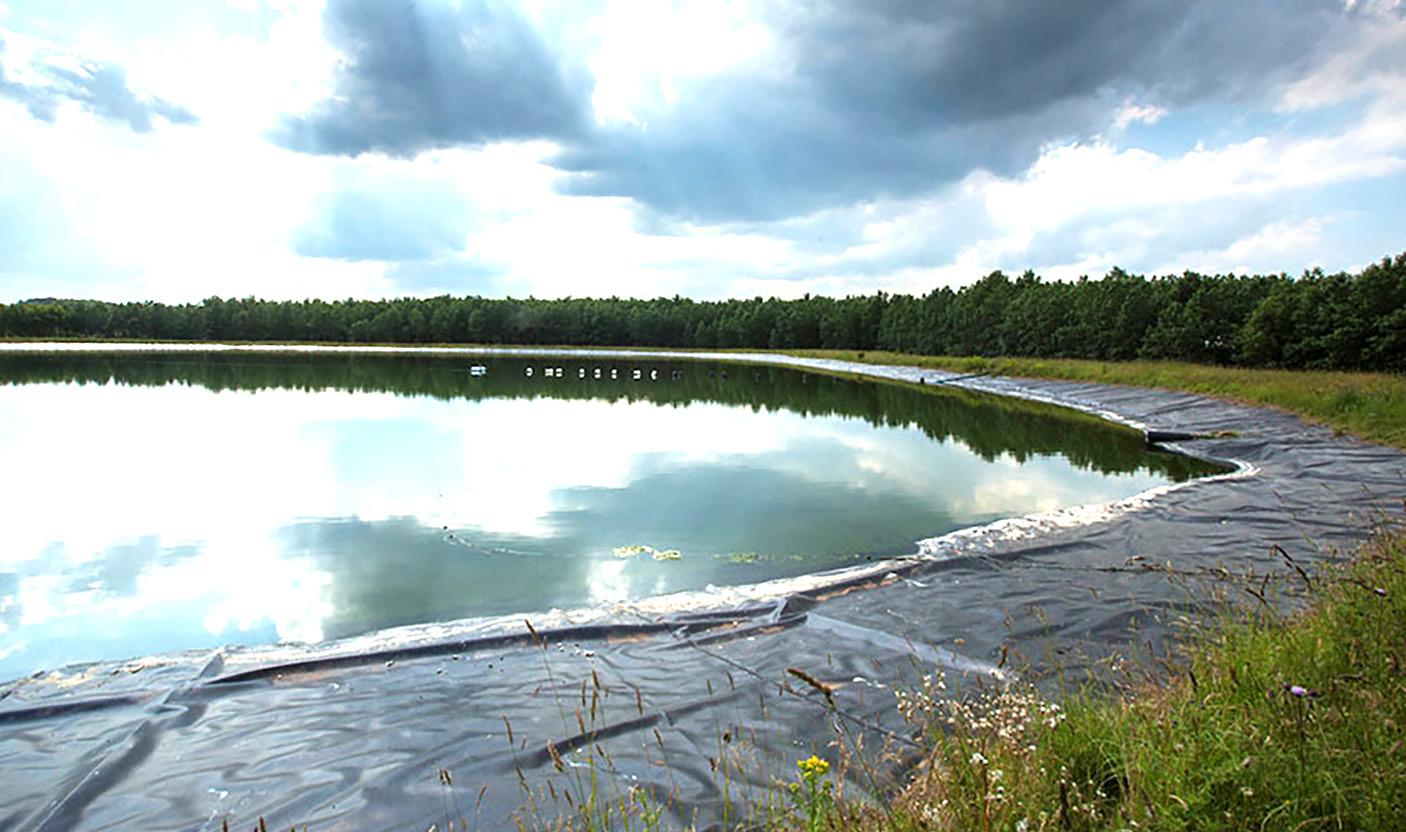


“The problem is that in an effort to preserve water, they are damaging the ecosystem. The irony of it all is that they are actually losing more water by storing it in a shallow dam (due to high evaporation rates) than by allowing it to be stored underground, as it has here since the beginning of time.”

Doug contacted the Canadian Federation of Independent Business (CFIB) for help, and while the Government of Saskatchewan would not engage on the topic while it is in litigation, CFIB is working hard to find other ways to support Doug and other farmers effected in his area. “Doug’s situation is both fascinating and devastating”, Brendan Rolfe, CFIB’s Senior Manager of Business Resources in Western Canada states, “it is Erin Brokovich-esque in its impact and intrigue.”
Water security should not come at the expense of 400 head of cattle 200 hundred of which have already paid for this mistake in resource management with their lives.
The Wilson family ranch has survived countless droughts, floods, and storms, but the WSA may be its biggest environmental disaster to date.
The WSA is a strong department that appears to operate independently of any checks and balances. It would argue that Doug wants to take water out of the system, when in fact, he is fighting for water to be returned to it. In terms of water management in Saskatchewan, the Water Security Agency is the judge, the jury, and, in Doug’s case, his potential executioner.
10 MEATBUSINESSPRO November 2022 meatbusinesspro.com
Are you passionate about natural water and green space conservation or wish to support the farmers that have fed our country since its infancy? Doug estimates that this affects an area of around 130 square kilometres, and he, the farms around him, and the environment need your help. Please contact us and/or write your MLA and MP about this issue if you can spare the time and consideration.
(CFIB). CFIB is Canada’s largest association of small and mediumsized businesses with 95,000 m embers (6,000 agribusiness members) across every industry and region. CFIB is dedicated to increasing business owners’ chances of success by driving policy change at all levels of government, providing expert advice and tools, and negotiating exclusive savings. Learn more at www.cfib.ca




11 meatbusinesspro.com November 2022 MEATBUSINESSPRO
VEMAG REPLACEMENT PARTS https://www.dhenryandsons.com
Brendan Rolfe is the Senior Manager of Business Resources in Western Canada for the Canadian Federation of Independent Business
FCC: 2022 CATTLE AND HOGS OUTLOOK UPDATE
SPECTRE OF DEMAND DESTRUCTION LOOMS OVER LIVESTOCK
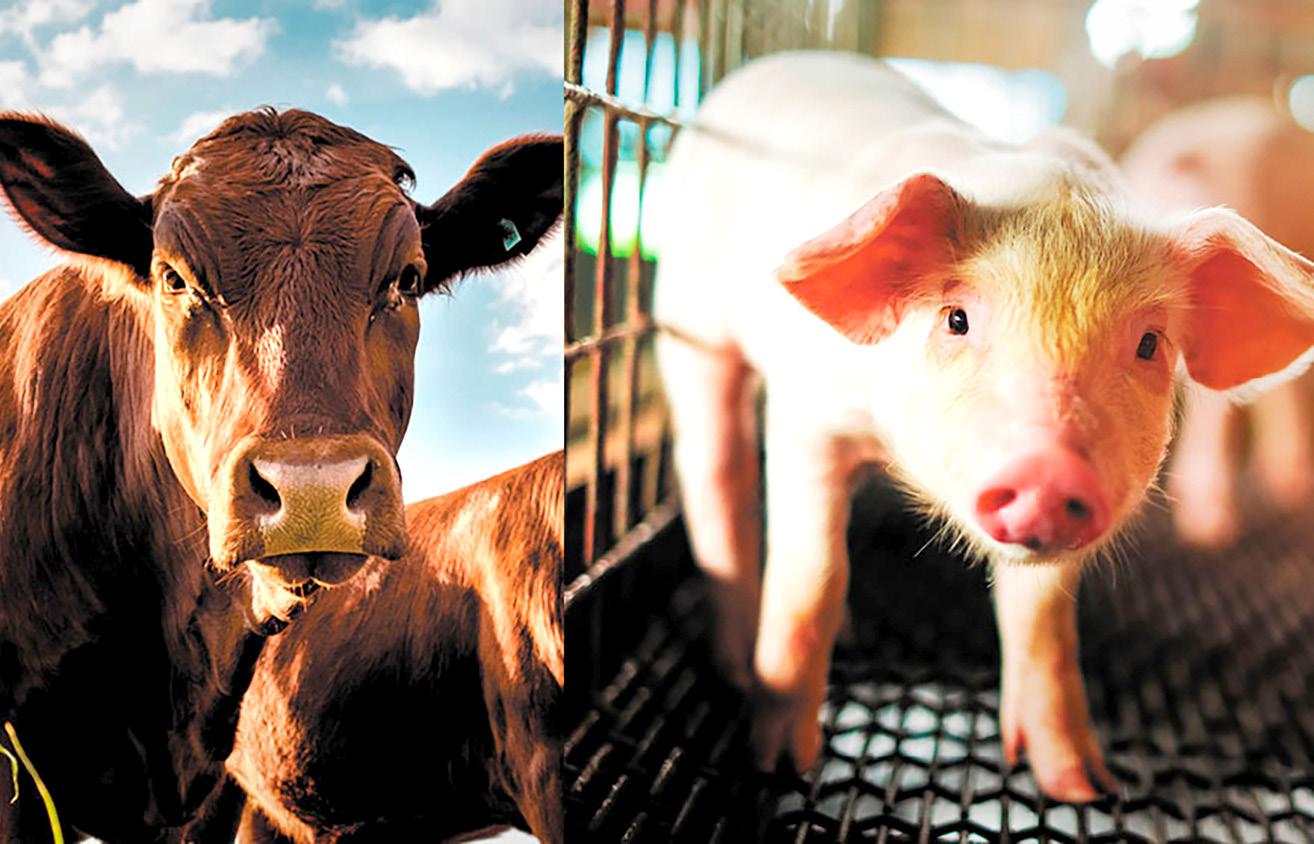
 By Martha Roberts, Economic Editor, Farm Credit Canada
By Martha Roberts, Economic Editor, Farm Credit Canada
Continued strength in cattle prices has pushed the average 2022 price for cattle in the East and West beyond our August outlook forecast. And while annual average hog prices are now forecast slightly under that last one, they’ll remain higher year-over-year (YoY) and well above their previous 5-year averages (Table 1). Insert table 1 here



Such strong prices will keep cow-calf profitability above breakeven throughout the remainder of 2022, while strength in feed costs and current packer “congestion” will continue to pressure feedlot profitability. The year’s margins are expected to be better than their respective 5-year averages for cow-calf operations and considerably weaker for feedlots, which should finally find some relief in 2023.

Hog margins are forecast to be mixed throughout the outlook period. Isowean margins in the east and west will remain below their 5-year averages this year, while farrow-to-finish operations’ margins will best their 5-year averages. Eastern farrow-to-finishers won’t quite reach the positive margins of their previous 5-year average, but they’ll be well above breakeven.
However, globalized inflation has raised headwinds to Canada’s livestock sectors with high feed costs and the possibly reduced global demand for meat. That’s influencing the current basis in Western Canadian cattle markets, as U.S. packers face limited supply from a shrinking herd and early drought-induced marketings.
12 MEATBUSINESSPRO November 2022 meatbusinesspro.com
AS HOG PRICES FADE SLIGHTLY TABLE 1: CATTLE PRICES ($/CWT) CONTINUE TO RISE AS HOG PRICES FADE SLIGHTLY
In its October outlook, the International Monetary Fund (IMF) downsized its expected global economic growth from 6.0% in 2021 to 3.2% YoY (falling to 2.7% in 2023) and projected inflation for 2022 at 8.8% (falling to 6.5% in 2023 and to 4.1% by 2024). Under such recessionary pressures, consumption of red meat is likely to decline.
At the same time, according to Anne Wasko, Canadian packers can’t get current. In the third quarter, slaughter numbers are down, and plants aren’t working to capacity as packers face challenges to move the beef along. Not even the highly supportive CAD can offset the influence of the supply congestion in Canada. Production is further delayed with feed costs rising faster than the loonie is falling and limited trucking available to move cattle after auctions.
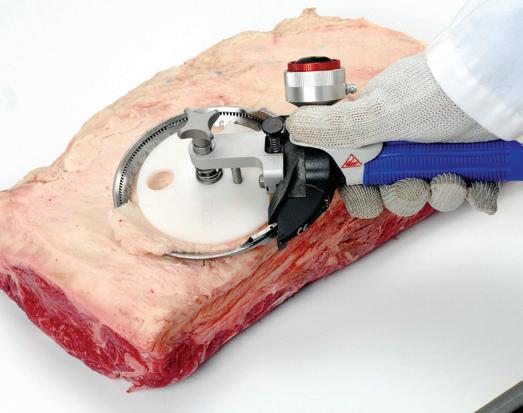
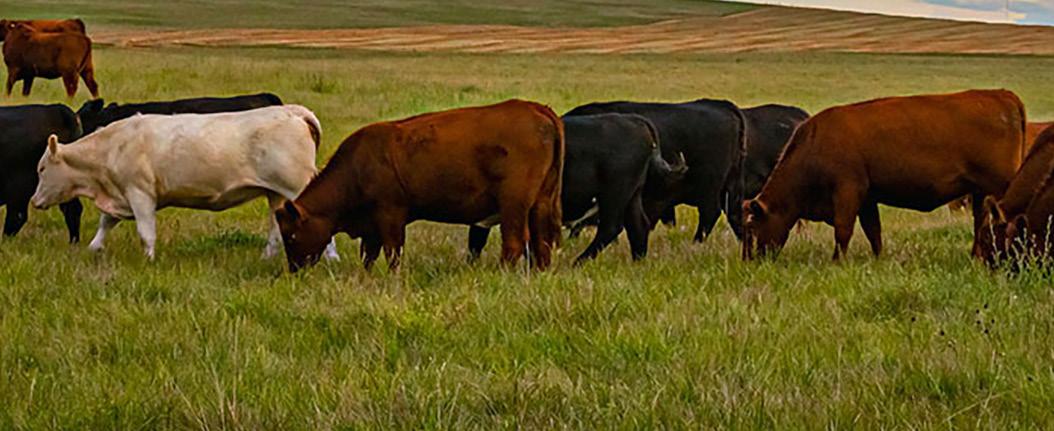
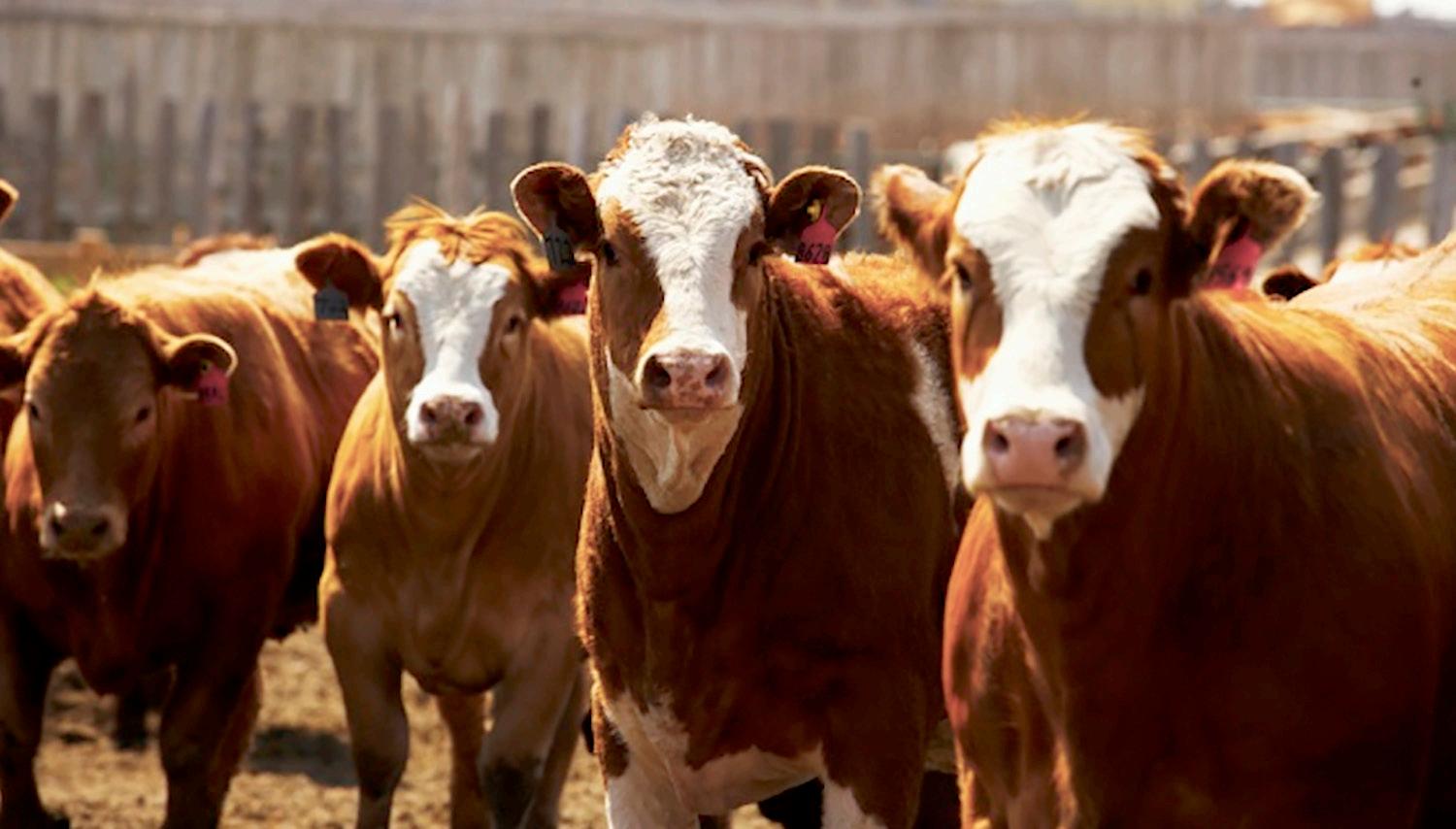
NSF International in Canada recently launched a new website - www.nsfcanada.ca - to give Canada’s growing and complex food and beverage industry easy access to the global public health organization’s expertise and services in Canada. The website combines information on the depth, experience and capabilities of the NSF International Canadian office with access to NSF International’s global services dedicated to food safety and quality.


In the U.S., a smaller sow herd will mean fewer farrows and a smaller swine herd overall (a 1.2% YoY fall). The USDA expects a smaller slaughter in 2022 and a second year of retracted growth in YoY pork production. Global demand for U.S. pork is expected to drop 8% YoY, and if pork supplies don’t get used, those currently strong prices may fall.



Evolving regulations across countries and increasing complexities associated with a globalized food supply network present challenges for NSF International clients in Canada and around the world. The new Canadian website offers expertise and services to help companies navigate these challenges, including certification and auditing, consulting, technical services, training and education, food and label compliance, packaging, and product and process development.
NSF International’s Canadian website provides information on the following services:





accredited International Association for Continuing Education and Training (IACET) site. Topics include HACCP, regulations (including FSMA), food science, food packaging,
about upcoming events and global news releases, submit a question or read an FAQ.
After a brief reprieve, feed costs are once again climbing. Our forecast for average feed barley in 2022, revised higher than our August projections, is now up 11.8% YoY and up 37.7% over the 5-year average (Table 2). Corn is also higher than in August, up 12.9% YoY and 37.1% over the 5-year average.


Certification & auditing: Third-party food safety audits and certifications, which are integral components of supplier selection and regulatory compliance. Accurate audits are the first step toward successful verification of a company’s food safety system, providing improved brand protection and customer confidence. Certifications and audits are available for animal and produce in the agriculture industry, GFSI certification and management system registration.
Consulting: A full-service team approach providing technical resources, expertise and insight for a wide range of food safety and quality services. NSF International
from on-site temporary or permanent technical staffing placements, and various types of consulting.
13 meatbusinesspro.com November 2022 MEATBUSINESSPRO
September/October 2017 CANADIAN MEAT BUSINESS 23 meatbusiness.ca YesGroup_CanadianMeatBusiness-Qtr-pg.pdf 1 2014-05-16 1:20:17 PM
INTERNATIONAL FOCUSES ON CANADIAN FOOD INDUSTRY WITH NEW WEBSITE FOR SERVICES IN
Global public health organization showcases services for Canada’s growing and fast-changing food industry https://www.yesgroup.ca TABLE 2: FEED COSTS ($/TONNE) STILL A DRAIN ON LIVESTOCK PROFITABILITY ON THE EVE OF DEMAND DESTRUCTION FEED COSTS ON THE RISE
A METEORIC RISE IN BEEF IMPORTS TAPERS
NSF
CANADA
FIGURE 1:
That’s happening in some of the world’s most important red meat markets. According to the IMF, China’s expected growth will falter in 2022, falling from 8.1% in 2021 to 3.2% in 2022. Not surprisingly, the USDA forecasts 2022 Chinese beef consumption to grow a relatively slow 2.6 % YoY, a slowdown from the previous 3-year average of 8.6% annual growth. And after growing their imports 31.8% each year on average between 2018 and 2021, imports are expected to grow 3.8% in 2022 (Figure 1) and to shrink 9.2% in 2023.
China’s recent incredible growth has led to the inevitable shift, but the lack-of-growth trend is also shown in the U.S. and Japan, Canada’s other two largest beef export markets.



Chinese pork consumption has almost recovered to preAfrican Swine Fever (ASF) levels and is on a YoY upswing as their domestic pork production picks up, and more meat becomes available. At the same time, their pork imports have fallen to just above pre-ASF levels (Figure 2).
The war has led to increased global energy and food costs, raising the cost of living to the point of civil unrest and protests. That’s been the case, especially for Europe, where meat consumption is expected to fall, with households reeling from energy costs in what is expected to be a cold winter.
CAN DOMESTIC DEMAND TAKE UP THE SLACK?
With global markets retracting, the North American market remains a brighter spot. The USDA forecasts U.S. per capita beef consumption to rise slightly in 2022 and again in 2023. Their pork consumption also remains high. In Canada, beef consumption was down in the first half of 2022, but expected to be up in the second half. Canadian pork consumption was up 2.8% YoY to start the year and is expected to remain strong.
BOTTOM LINE
Prices for Canada’s red meat sectors are currently strong and expected to remain elevated throughout the outlook period. But as the world economy continues to decline and export markets respond to weaker conditions, more pressure could be applied to prices. Certainly, Canada’s performance in red meat markets could take a big step backwards, especially from the highs of 2021 and it may be more a question of “when,” not “if.”
China’s economic slowdown will reverberate throughout Asia, crimping growth and downshifting meat consumption in neighbouring economies.
THE WAR DOING NOBODY ANY FAVOURS
The Russian invasion of Ukraine has created logistical logjams and supply-side commodity volatility, impacting almost every sector of global agriculture. It can be tied directly to the growth in feed costs currently plaguing the North American livestock industries.
14 MEATBUSINESSPRO November 2022 meatbusinesspro.com
FIGURE 2: CHINESE PORK IMPORTS IN LINE WITH PRE-ASF LEVELS
CHINA STEPS BACK
U.S. MEAT SECTOR RELEASES FIRST-EVER DATA REPORT ON ENVIRONMENT, OTHER KEY INDICATORS

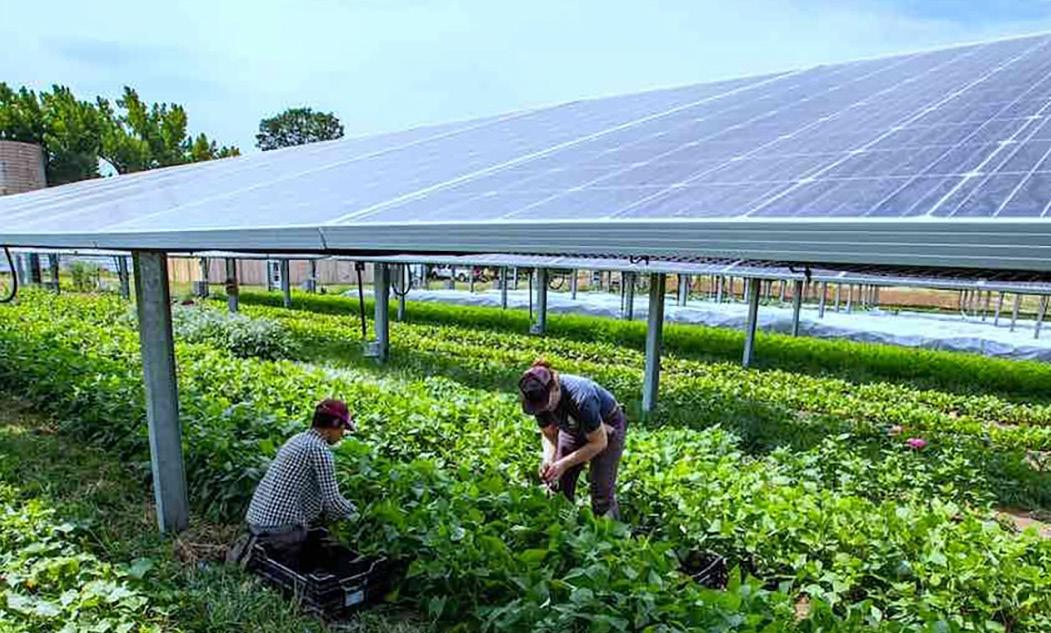
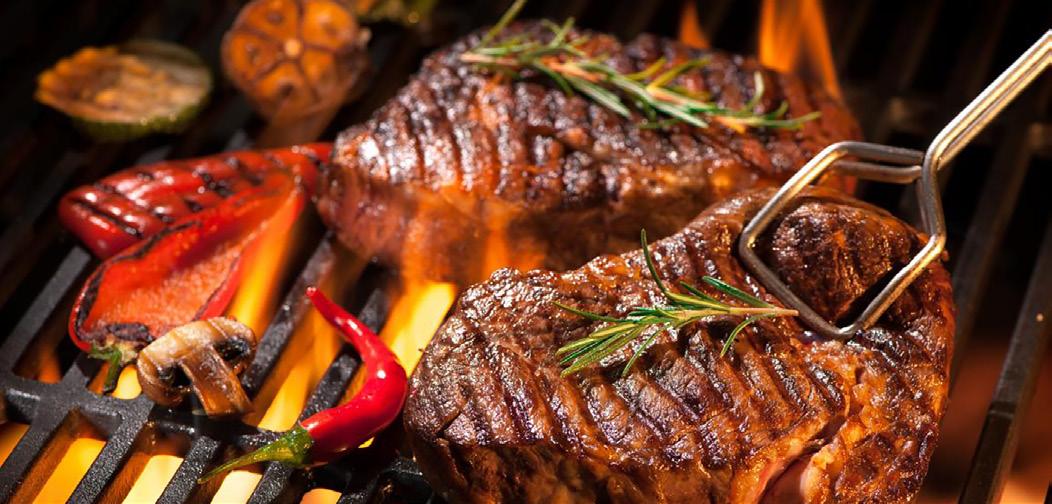

A major new report released at the recent United Nations Climate Summit in Sharm el Sheikh, Egypt, reveals that about 81% of facilities reporting data are covered by Meat Institute members’ commitments to reduce greenhouse gas (GHG) emissions.
With 100% of the Meat Institute’s large U.S. members (more than 2000 employees) submitting data, the report covers an estimated 90% of meat sold in the United States (by volume) and sets the first ever baselines for measuring progress toward ambitious targets for environmental sustainability, animal care, food safety, worker safety, and food security.
Meat Institute President and CEO Julie Anna Potts stated, “98% of American households purchase meat, putting our sector undoubtedly at the center of solutions for healthy diets, healthy communities, and a healthy planet for generations to come.
FURTHER KEY FINDINGS INCLUDE:
Supporting NAMI’s commitment to measure and fill the “protein gap” for needy families by 2025, 78% of reporting companies donate money or products to food banks and charities, including more than $9 million announced this year to combat hunger by building or expanding food banks’ capacity to safely receive, store, package, and distribute fresh meat hungry families need.
82% of reporting facilities are covered by a company commitment to minimize packaging waste, and 71% are covered by a company commitment to reduce food waste.
“The Meat Institute’s first-ever continuous improvement report is a game changer for transparency in the sector setting transparent baselines that will allow us to measure progress and verify our sector’s contributions to global goals.”
96% of reporting facilities that conduct meat processing require suppliers to maintain a written animal welfare program based on NAMI Animal Handling Guidelines. 98% of reporting facilities have a multidisciplinary team that periodically reviews food safety programs and takes improvement actions.
To read the full report and for more information about the Meat Institute’s continuous improvement framework and targets, click here.
15 meatbusinesspro.com November 2022 MEATBUSINESSPRO
WMIN ANNOUNCES 2022 MOST IMPACTFUL WOMAN
WMIN ANNOUNCES 2022 MOST IMPACTFUL WOMAN
The Women’s Meat Industry Network (WMIN) has announced Kate Rome, President of Rome Grinding Solutions, as the Most Impactful Woman of 2022.
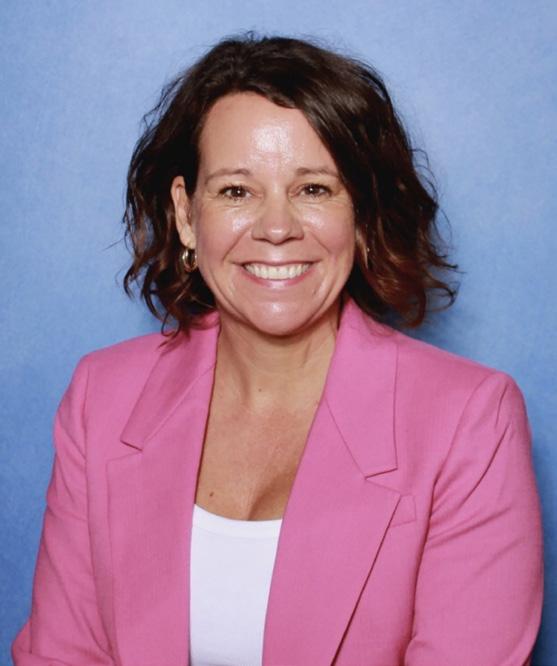
As the first woman honored with the Most Impactful Woman of the Year Award, Rome demonstrated her leadership in the meat and poultry industry and her passion toward the education, development, and promotion of women in the industry. She championed the WMIN mission to make achieving the powerful benefits of gender diversity a shared goal in the meat and poultry industries.
“I am grateful for the opportunity that I have been given to make a meaningful impact in the professional lives of women over the past 6 years,” Rome said. “It has honestly been the highlight of my career, and I will continue pushing forward to achieve equality for women in our industry.”
“As the president of Rome Grinding Solutions, Rome has completely changed the culture of the company during her tenure,” said Cara Godack, Director of Business Development at Rome Grinding Solutions. “She has increased the number of female employees by 25% and has closed the wage gap for women employed by Rome. In addition, Rome has talked with other manufacturers and questioned them on diversity, which has prompted many to rethink hiring procedures.”

WMIN is proud to represent over 900 individuals in the meat and poultry industry. And the Impactful Woman of the Year Awards are an opportunity to recognize these outstanding WMIN members who go above and beyond
in working toward a shared mission.
The top nominees were recognized at the WMIN Event at NAMI’s Protein PACT Summit this October. Nominees were evaluated by a committee of WMIN members.
IMPACTFUL WMIN OF THE YEAR NOMINEES INCLUDED:
• Sharon Beals, Chief Food Safety Officer, CTI Foods
• Dr. Sara Crawford, President, Sustainable Environmental Consultants
• Darla Kiesel, Co-Owner, Dewig’s Meat
• Barbara Masters, VP of Regulatory Policy, Food and Agriculture, Tyson Foods
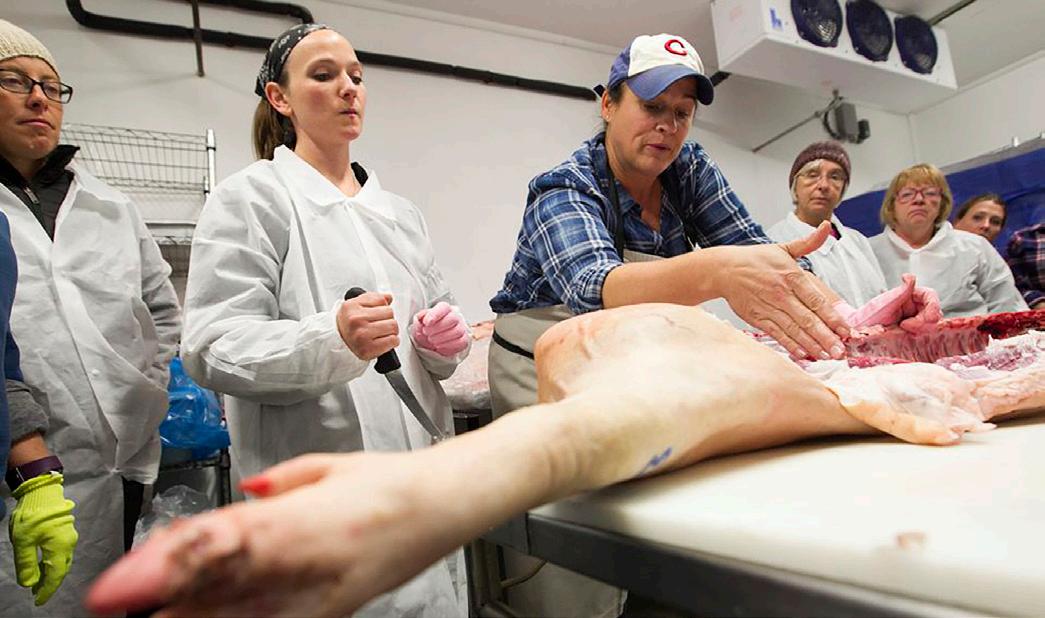

• Casey Gallimore, Director of Regulatory Policy, North American Meat Institute
About the Women’s Meat Industry Network (WMIN) WMIN is cross-sector group of smart, talented women looking to develop both professionally and personally in an industry that is traditionally male dominated. It is a network to connect people who share the passion of helping women flourish within the meat and poultry industries. https://wmin.org/
16 MEATBUSINESSPRO November 2022 meatbusinesspro.com

https://www.cfib.ca
A CANADIAN STARTUP IS DISRUPTING THE MEAT INDUSTRY
Increasing Quality, Consistency and Food Safety while Reducing Food Waste
UBI Meat is a new startup based in Canada with cofounders that have more than 50 years of combined experience in the meat industry.
CEO and co-founder, Sebastian Victorica (originally from Uruguay), is an experienced international meat trader with more than 25 years in the industry. As many traders have experienced, Victorica suffered a number of losses due to claims and quality inconsistencies in the product he was selling. He knew something could be done to solve this problem in the meat supply chain affecting all the players from slaughterhouses to traders/importers, to wholesalers/restaurants and eventually to consumers.

Together with Martin Rojas and Kyle Pilot, they created UBI Meat to solve this problem and become the standard for protein quality assurance and grading. Rojas is also Uruguayan and has more than 25 years in the meat industry but on the production side working in two of the biggest meat plants in Uruguay. Pilot has 20 years of experience developing apps and scaling technology businesses
Last year they were among one of the 11 companies (out of hundreds) selected to participate in the Techstars Farm to Fork 2021 T4 program sponsored by Cargill and Ecolab.
Consumers are demanding more transparency. They have a clear preference for graded meat as they consider it as being better quality and safer. Now with UBI Meat, processors have a unique opportunity to access technology that has not been used before.
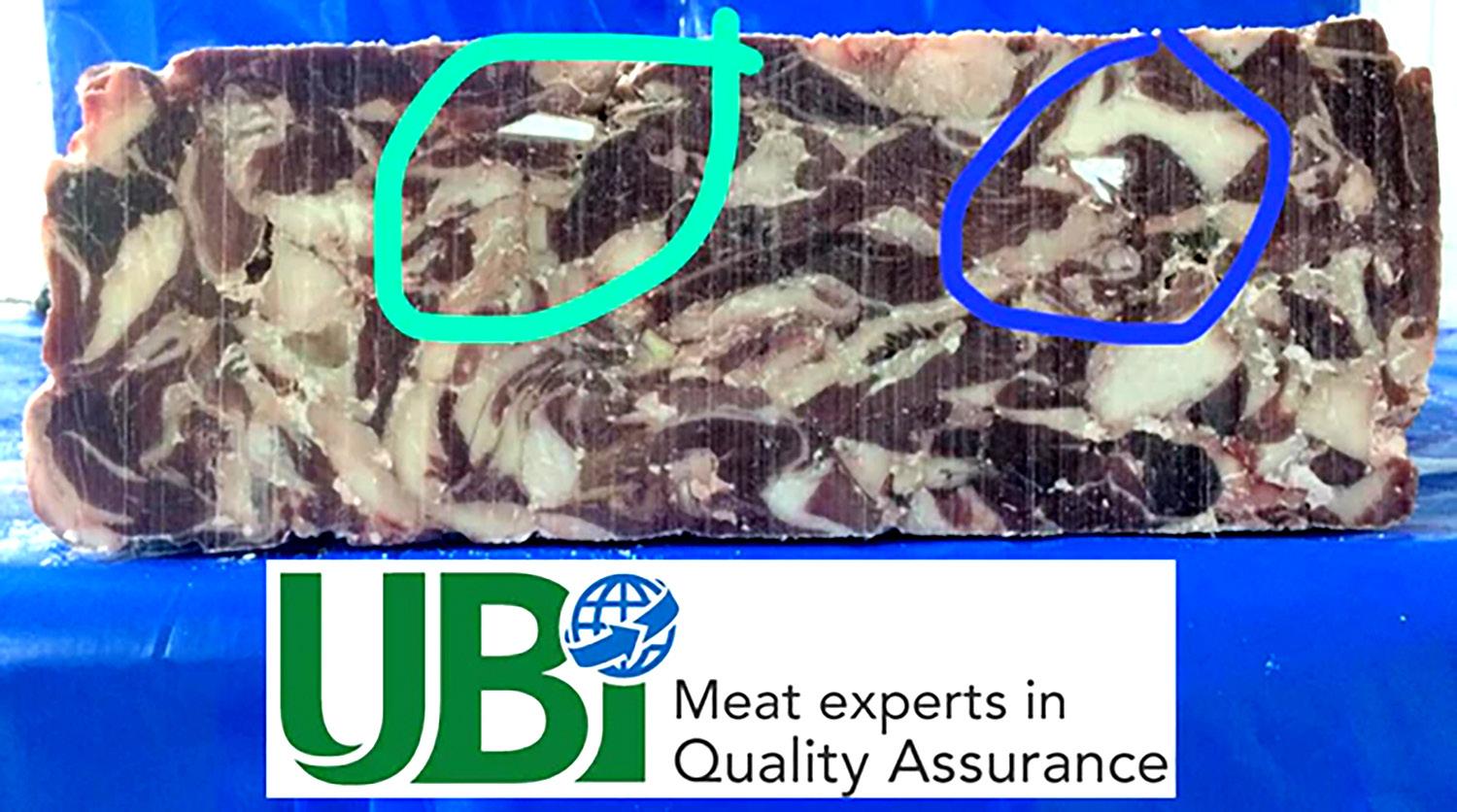

THERE ARE TWO BASIC WAYS OF GRADING BEEF TRIMMINGS:
1. One method uses an expensive x-ray machine. This method is accurate but less than 10% of the market has access to it.
2. The other method is what the rest of the world uses visual inspectors and they can get it wrong more than 10% of the time.

Improper grading can cost processors and other meat industry players millions of dollars due to unrealized revenue, costly claims and product waste.
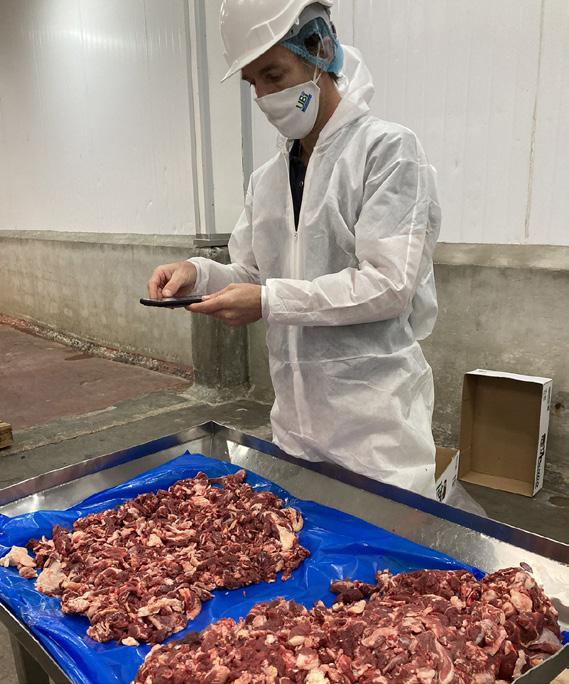
18 MEATBUSINESSPRO November 2022 meatbusinesspro.com
UBI Meat’s solution is a grading and monitoring platform that leverages artificial intelligence (AI) and machine learning (ML). For beef trimmings, they created a solution that combines the accuracy of an x-ray machine (without exposure to radiation) with the convenience and affordability of a phone. Now suppliers can measure and grade beef trimmings with one click of their smart phone.
They also provide a solution for the grading of the carcasses via their unique shroud and which also can be accessed by a button click on a smart phone. UBI Meat claims they can provide up to 98% accuracy in this type of grading.
With this technology, meat industry professionals will be able to increase revenue by guaranteeing a consistent product and drive production costs down by eliminating the need to over buffer as well as reducing the risk of costly claims.


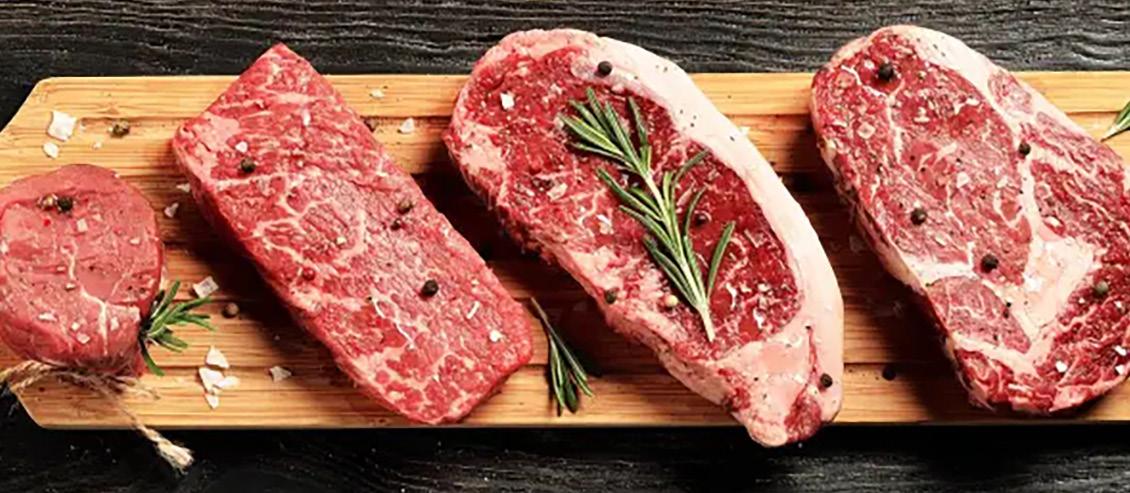
Their platform is user-friendly and provides access to traceability, historical records and insight into employee performance. At this time, UBI Meat has the only solution in the marketplace that can offer these
THE BEST DEFENSE A STRONG OFFENSE
They ensure trust and transparency by providing full traceability and information via a scannable QR code on the bags/boxes of the product to show the grading or animal welfare.
PROMOTING THE HEALTH BENEFITS
(volume), per user, a first-of-its-kind software as a service platform for the meat grading industry so meat plants start saving from day one.
By Ronnie P. Cons
Red meat is often wrongly portrayed as being unhealthy. some in the media as unhealthy or not environmentally friendly.
Covid-19 has created the need for the digitization of the meat industry and UBI Meat has been working to transform the industry since well before the pandemic. They are enabling a new era of smarter food safety, providing traceability, tools for outbreak prevention, retail modernization and food safety culture. Meat processors now have access to consistent and meaningful data that empowers them to implement food safety solutions.
Vegan, fish and other non-meat diets have been proposed as healthier alternatives. The result of this onslaught of negative meat messages has influenced many families to cut back on their meat and poultry purchases. Perceptions may reality but truth trumps misinformation. Parents and other consumers want what is best for their health and that of their families. They are also aware that a lot of false information is out there and as such, are open to scientific facts that can correct their misconceptions.
This provides an opportunity for retail meat departments to implement an instore ‘Healthy Meat Facts’ nutritional campaign to set the record straight and convince their customers that meat and poultry are actually good for one’s health and that they should increase rather than decrease their purchases of it. The campaign outlined below can have a direct impact on sales:
Start by displaying instore posters promoting the nutritional value of meat. They should be innovative, eye catching and be designed to specifically contradict any meat myths. The comments should all be literature based quoting research papers or MDs for maximum effect. Various posters should be made - each with a brief but powerful message covering one theme.
liver, 625 spinach.
Iron found found in absorption.
2. Eat Meat Being deficient linked with Dr. Charlotte California, Zinc is preserves 3. Boost Due to antibodies chronic
4. Power The protein
Muscles building The protein growth
Posters can convey the following healthy meat fact messages:
Customers are already monetizing their meat production with AI and predictive analytics. AI is having a major impact and companies in the meat industry are becoming more aware of how this new technology can increase efficiency and profits, reduce meat waste, and protect against supply chain disruptions.
1. Let’s IRON out the Truth on Meat! “You would need to eat a massive amount of spinach to equal (the iron content) in a steak,” says Christopher Golden, an ecologist and epidemiologist at Harvard University in Cambridge, Massachusetts. (As quoted by nature.com in the article ‘Brain food- clever eating’.)
For a woman to receive her recommended daily intake of 18 mg of iron, she would need just 300 grams of cooked bovine
UBI Meat is now calibrating their trimmings solution to help pork suppliers to benefit and switch from grading the pork trimmings visually to this first-of-its-kind solution in the pork industry via AI and ML.
5. Meat Meat contains body cannot isoleucine, threonine, protein.
6. Eat Meat Meat contains production functioning Say ‘hello’ acid, vitamin The line only apply meat health Facts’ nutritional and poultry. education

Ronnie P. meat and
https://www.mmequip.com
19 meatbusinesspro.com November 2022 MEATBUSINESSPRO
22 CANADIAN MEAT BUSINESS September/October 2017
SATELLITE SMARTPHONES COULD EVENTUALLY ANSWER THE CALL FOR RURAL CONNECTIVITY
While initial services are limited, new technology and strategic partnerships will fuel growth
Smartphones with satellite connectivity could eventually prove vital for rural communities, delivering voice, data and broadband to Americans living in underserved markets. Advancements in battery density, chipset processing power and antenna technology have now made it possible for smartphones to connect with satellites for some basic services.
Satellite smartphones have gained momentum on recent announcements by Apple, T-Mobile and SpaceX. In conjunction with Globalstar, Apple has equipped its new iPhone 14 with satellite service, giving them a two-year lead in the market. T-Mobile and SpaceX announced plans to offer smartphone satellite connectivity, with beta trials set to begin towards the end of 2023.




According to a new report from CoBank’s Knowledge Exchange, satellite smartphones could have a profound impact on residents of rural communities as the technology advances and more robust service offerings become available.

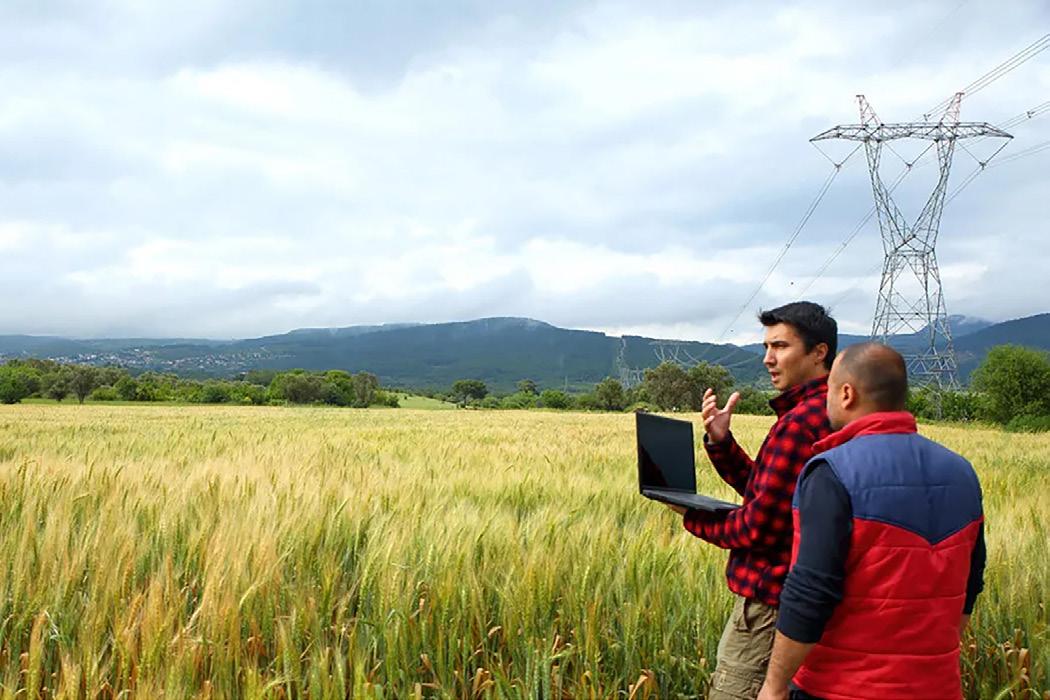
“Initially, the service options available through satellite phone connectivity will be limited to basic text and SOS messaging,” said Jeff Johnston, lead communications economist for CoBank. “But as new satellites are launched over the next several years, voice calling and more advanced data applications should become available. And smartphones equipped with satellite technology will work anywhere in the U.S., regardless of cellular coverage.”
The ability to make calls and send messages in remote areas where no cellular service exists would provide some rural residents with options and flexibility that were previously unimaginable. However, cost will be a key determinant of consumer adoption and the finer details on pricing remain unclear.
20 MEATBUSINESSPRO November 2022 meatbusinesspro.com
“Satellite smartphones need a clear line of sight with the sky which would limit the service in urban and suburban areas,” he said. “And the capital required to create network capacity in a satellite network comparable to what is currently available in terrestrial networks would be incredibly high. The return on investment would never pencil out.”
Wireless operators interesting in pursuing satellite connectivity could take the T-Mobile approach and offer the service directly with SpaceX or a similar satellite operator. The other option is to partner with Apple, or presumably Samsung as they are also expected to partner with a satellite operator directly.


‘WOULD OPEN DOOR’ TO NEW BEEF MARKETS

Watch a video synopsis and read the report, Niche for Now, Satellite Smartphones Could Answer the Call for Rural Connectivity.

Proposed 30,000-square-foot beef abattoir in Cloverdale would be B.C.’s largest such facility
By Amy Reid,
Peace
Arch News
A federally licensed beef processing facility is in the works in Surrey, BC.
Apple is providing the service free of charge for the first two years, and it remains to be seen what they will charge after that. However, it is reasonable to assume that Apple will keep the price low and use the service to increase iPhones sales, given its first mover advantage. T-Mobile said satellite services will be free on its most popular plans, but it’s unclear what those plans will cost when T-Mobile rolls out the service in 2024. While it might appear that consumers can eventually look forward to cancelling their wireless carrier service and using satellite service exclusively, Johnston said this is highly unlikely.
“There’s a new building coming forward, a new abattoir, I think that’s the French pronunciation of slaughterhouse,” said Councillor Mike Starchuk. “So Surrey will have a newer facility with a better capacity so people will have the ability to not have to ship an animal to Alberta to have
Agricultural
Agricultural Land Reserve at 5175 184th St. The planned 30,000-square foot abattoir in Cloverdale would process up
small by industry standards, compared to the largest meat
21 meatbusinesspro.com November 2022 MEATBUSINESSPRO
and Food Sustainability Advisory Committee.”
proposed facility
be fully enclosed and designed
SURREY
The
would
NEW
SLAUGHTERHOUSE
Continued on page 32
https://www.tcextrade.com
DOUG EASTERBROOK NAMED ONTARIO’S

FINEST BUTCHER
Doug Easterbrook of Townsend Butchers, Simcoe took home the title of Ontario’s Finest Butcher in a competition hosted by Meat & Poultry Ontario (MPO) in October.

Easterbrook is a 4-time veteran to the competition who also competed at the World Butcher Challenge as part of team Canada earlier this year. He battled his way through 17 of Ontario’s best butchers in an elimination round held on September 12 and was one of 3 finalists who moved on to the final round held October 14 at the Meat Industry Expo in Niagara Falls.
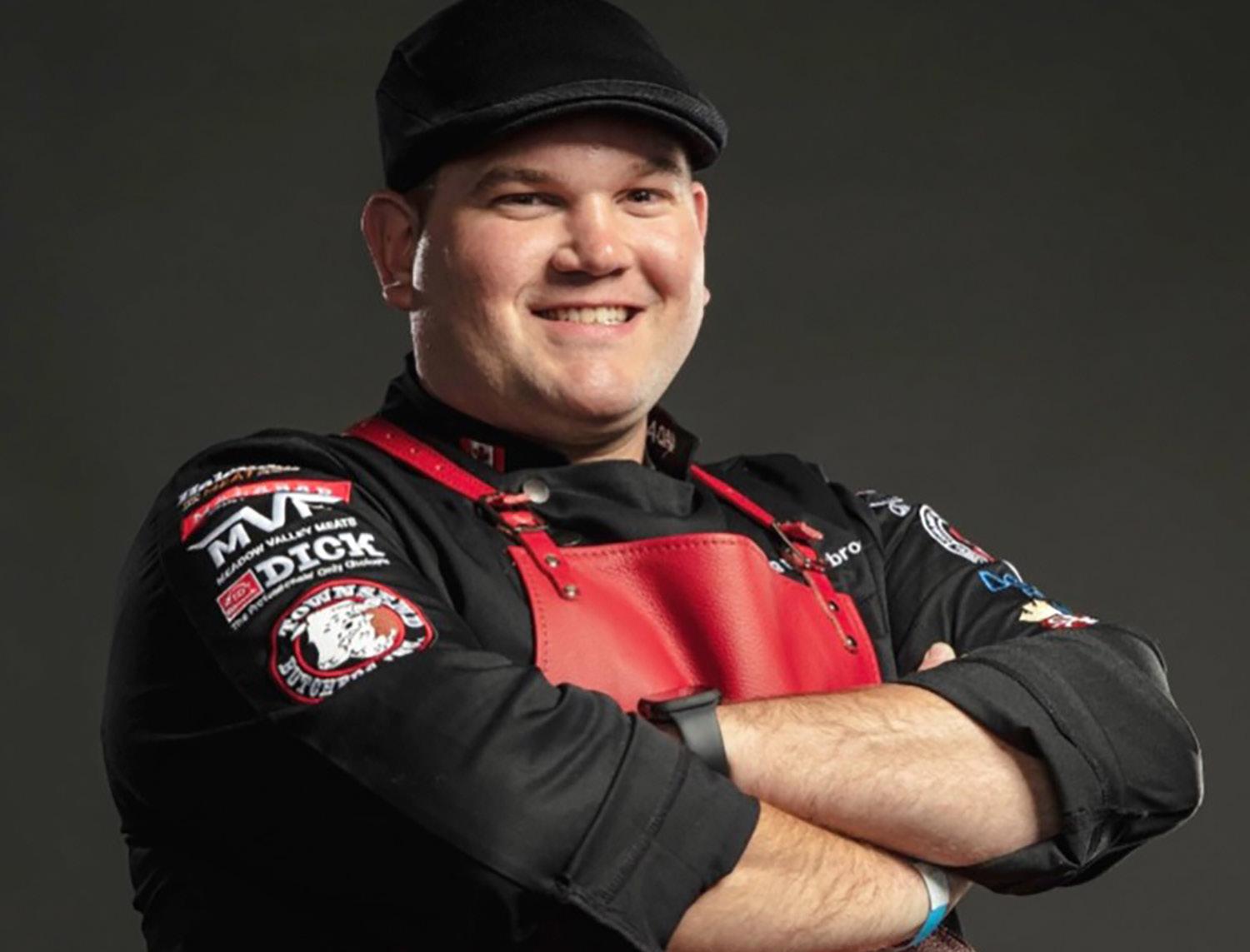
“It’s great to be a part of such a great competition. It gets you out of your comfort zone and puts your skills and experience to the test,” said winner, Doug Easterbrook. “It’s a fast 30 minutes, you have to be focused and prepared going into it.”
The theme for this year’s final ‘black box’ round was ‘Bougie Bites’ and Easterbrook, along with fellow finalists, had 30 minutes to transform 2 whole chickens, a pork loin and beef shoulder clod into several upscale, display-ready items. The finalists were judged on their level of skill, creativity and consumer-appeal. The four judges’ combined scores determined it was Easterbrook who would take home the title.
"Meat cutting is a lost art, and our industry has a constant need for skilled Butchers in Ontario." says Franco Naccarato, Executive Director of MPO. "We are excited to see this competition grow year over year, showcasing the amazing talent of butchers from across the province."
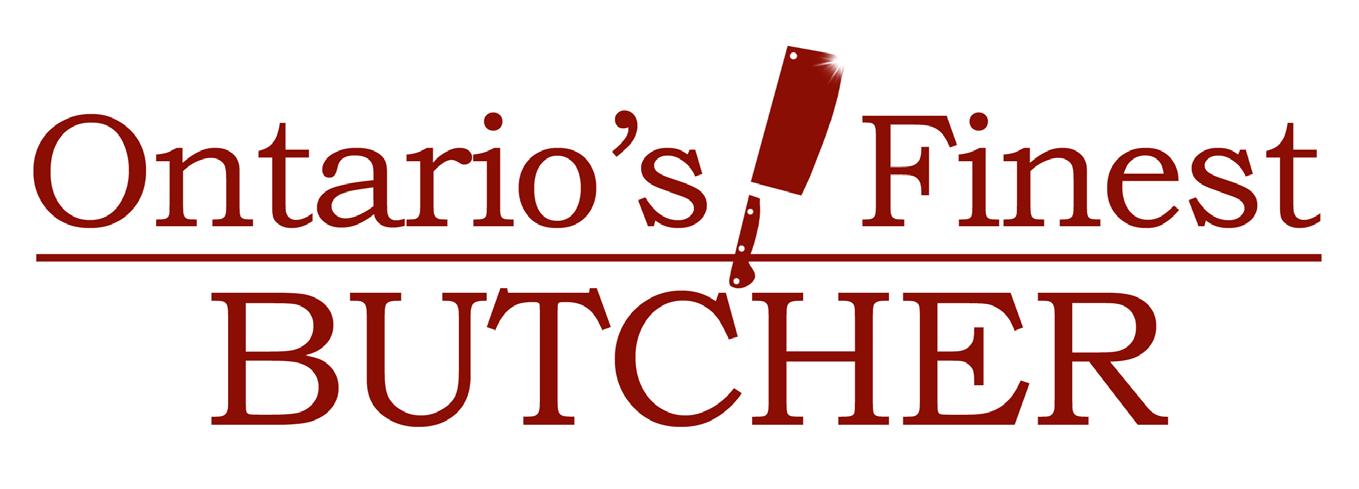
“Over the years of being involved with this competition it has opened up many opportunities and built great relationships with some true professionals within the industry.” said Easterbrook.
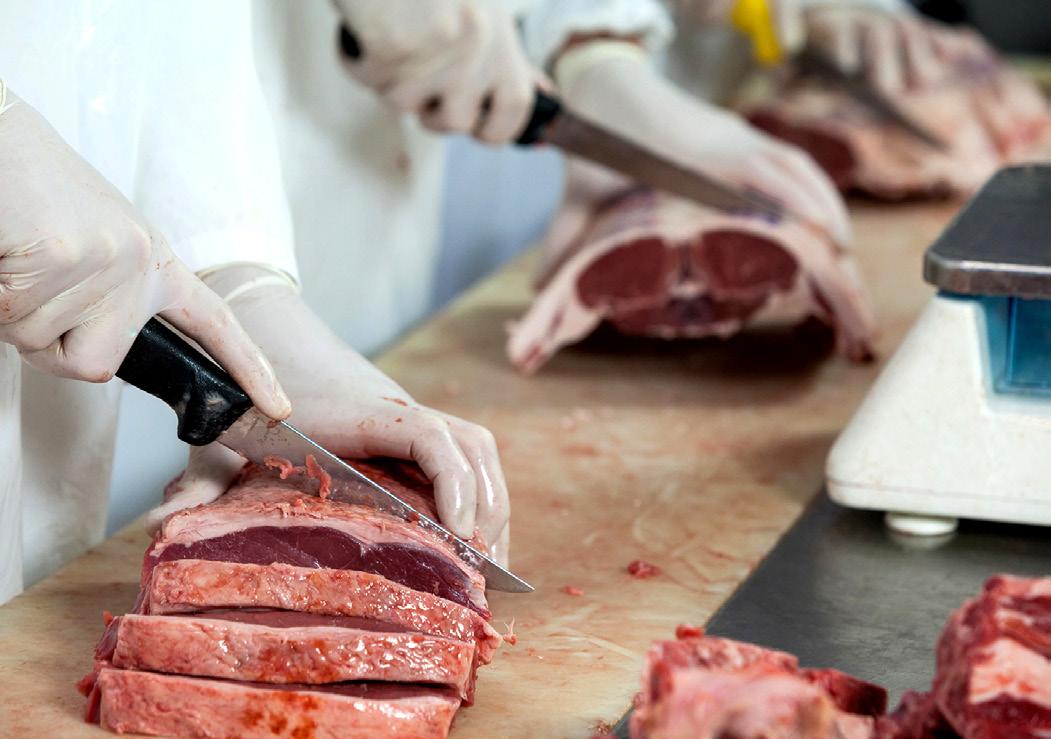
22 MEATBUSINESSPRO November 2022 meatbusinesspro.com
SIMCOE BUTCHER BRINGS HOME THE BLACK JACKET.
In addition to donning the official champion’s black jacket, Easterbrook took home a prize package valued at over $3000 including a Minimax Big Green Egg™ Ultimate Kit, eno La Plancha Grill, Victorinox Butcher Knife set from YesGroup, a YETI gift package, and cutting board resurfacing services from Ecoboard.
Yes, I think we were the first farm east of Ontario as far as I understand. I’m not sure why the eastern associations wouldn’t have previously nominated anybody because there are many farms here on PEI doing every bit as much as we are as to attain a high level of sustainability. Anyway, we were very surprised when the PEI Cattleman’s Association nominated our farm.
This year’s competition footage can be watched at https://www.youtube.com/ watch?v=w0bw1B18EYQ
CMB: And then you were attending the Canadian Beef conference in Calgary and you won.
ABOUT MPO
Meat & Poultry Ontario (MPO) is the representative voice of Ontario’s meat industry.

DF: Yeah! That was a very nice moment for us. But I don’t like to use the word win actually. However, being recognized for our commitment was a real honour. If you want to know the truth, it was a pretty humbling experience. As I said to CBC when they phoned me after the conference, I was just floored, really couldn’t believe it.
CMB: So now that you have been recognized, do you think that will draw more attention and garner more nominations out of Atlantic Canada going forward?

Ontario’s meat and poultry sector employs 25% of Ontario’s food and beverage processing industry the single largest manufacturing employer in Ontario and generates $11.2 billion of the province’s $45 billion food and beverage processing industry revenue. For more information, visit https://www.meatpoultryon.ca/
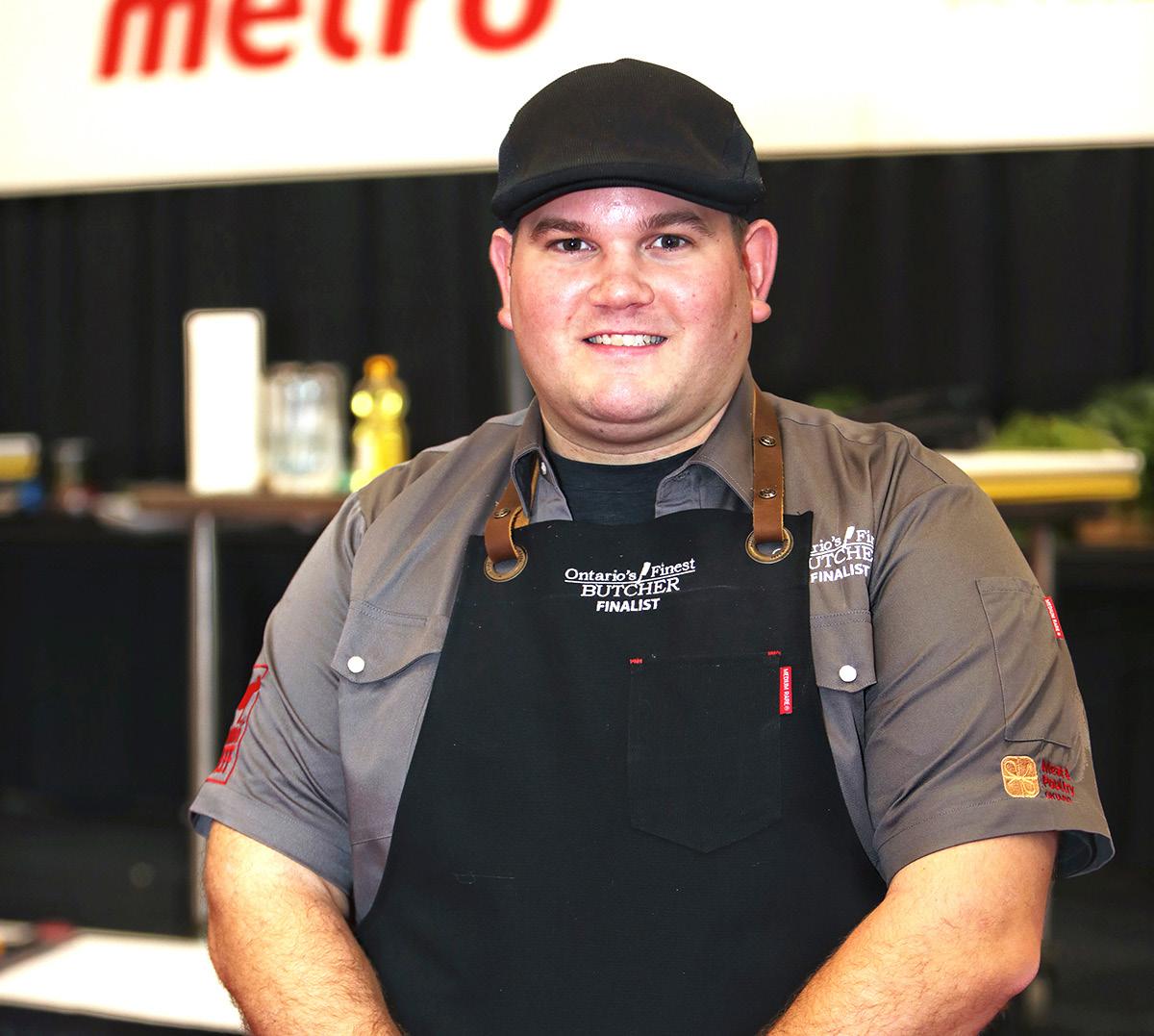
DF: Absolutely. We’ve gotten a lot of good press highlighting the island cattle industry. I’m positive you’ll see
https://www.yesgroiup.ca
23 meatbusinesspro.com
September 2022 MEATBUSINESSPRO September/October 2017 CANADIAN MEAT BUSINESS 17 meatbusiness.ca
USASK ANNOUNCES NEW FOOD INDUSTRY MANAGEMENT DEGREE




A new undergraduate degree program at the University of Saskatchewan (USask) meets the growing industry need for graduates with interdisciplinary training in food science, agribusiness, and marketing.
Students in the new Bachelor of Science in Food Industry Management degree will learn advanced knowledge of food science, agri-food economics, food management practices, and food industry policy to prepare them for jobs in the booming agri-food sector.
In 2021, Agriculture Canada and Agri-Food Canada reported that the agri-food sector is the cornerstone of the Canadian economy, generating $134.9 billion and accounting for 6.8% of the country’s gross domestic product. It also provided one of every nine jobs in Canada in 2021.
The new USask degree program will be housed in the College of Agriculture and Bioresources, with students taking classes from both the Department of Food and Bioproduct Sciences and the Department of Agricultural and Resource Economics.
“The new BSc in Food Industry Management degree is a natural fit for the College of Agriculture and Bioresources,” said Dr. Angela Bedard-Haughn (PhD), dean of the College of Agriculture and Bioresources. “Our college works hard to ensure that our students will graduate with what they need to grow their future: hands-on scientific training that is industry endorsed and a foundation of professional career skills. With this new degree program, we continue to strengthen and diversify our student community.”
24 MEATBUSINESSPRO November 2022 meatbusinesspro.com
Students in the BSc in Food Industry Management program will receive experiential learning opportunities in management, entrepreneurship, leadership, and product development for the agri-food sector. These opportunities will allow them to apply their studies to real world experiences such as developing business plans for new products with mentorship from entrepreneurs and business leaders.
Students can enter the BSc in Food Industry Management program directly from high school or transfer in from another post-secondary program. The new program is accepting applications for admission with the first cohort to begin classes in September 2023. Questions about the program can be directed to AgBio Student Services.


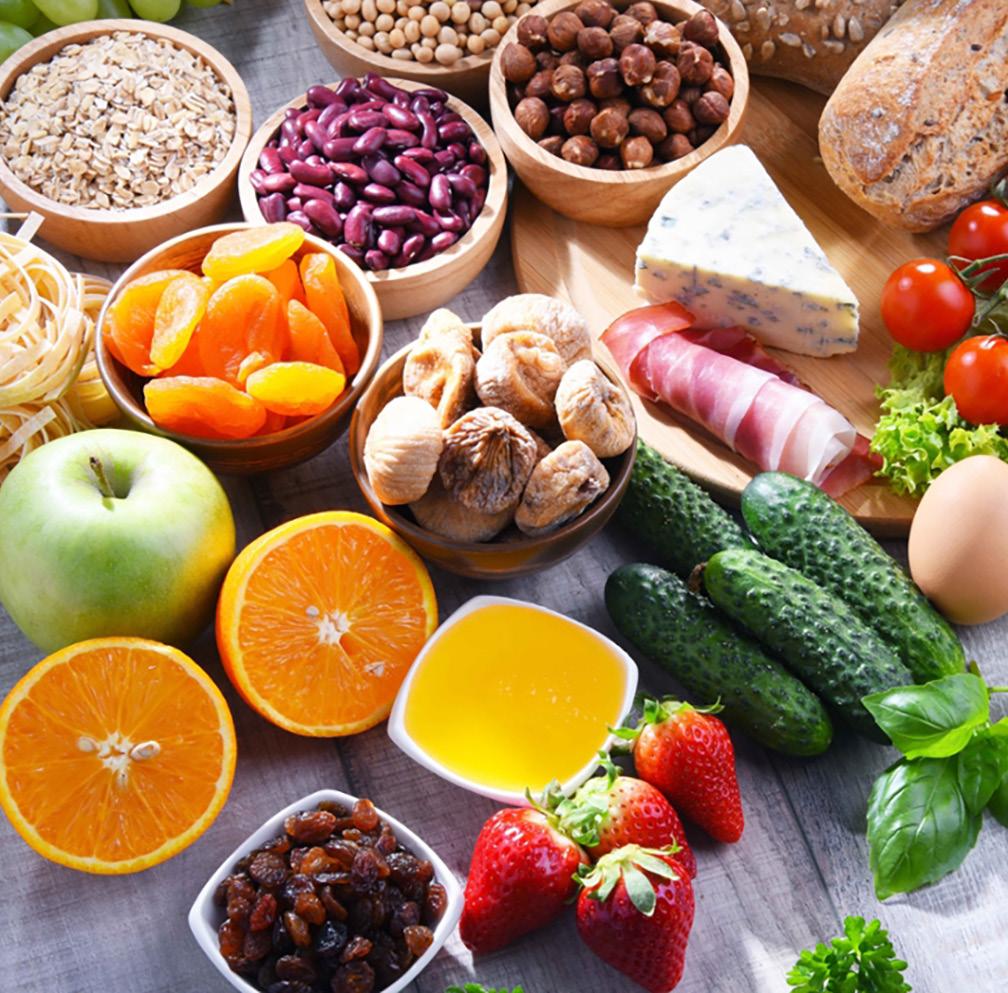

“There is strong demand for graduates with a scientific background in food science together with expertise in business and marketing for private sector and government jobs,” said Dr. Darren Korber (PhD), department head of Food and Bioproduct Sciences at USask. “This degree prepares students for a variety of careers in the agri-food sector including food operations manager, food policy and regulatory analyst, food marketing manager, food processor and product development consultant, and food industry entrepreneur.”

25 meatbusinesspro.com November 2022 MEATBUSINESSPRO
U.S. SUPREME COURT TO RULE ON PORK INDUSTRY CHALLENGE TO CALIFORNIA LAW
By Nate Raymond, Reuters
U.S. Supreme Court justices on recently questioned whether upholding a California law banning the sale of pork from pigs kept in tightly confined spaces would invite states to adopt laws imposing their political or moral views outside their borders.
The justices heard arguments in an appeal by the National Pork Producers Council and the American Farm Bureau Federation of a lower court’s decision to throw out their lawsuit seeking to invalidate the animal welfare measure. It was approved by voters as a 2018 ballot initiative called Proposition 12 to bar sales in California of pork, veal and eggs from animals whose confinement failed to meet certain minimum space requirements.
The justices appeared torn over whether the law went too far by forcing farmers in other states to change their practices in order to sell pork in the most populous U.S. state. Questions from some justices suggested that the court could allow a pork industry-backed lawsuit challenging the law to play out in the lower courts rather than rule on its constitutionality.

Justices across the ideological spectrum appeared concerned that a ruling in California’s favor might encourage more states to adopt moral or ideologically driven sales laws affecting national commerce, promoting conflict among states. They raised the prospect of states restricting sales from out-of-state businesses that did not comply with policy preferences in areas such as immigration, organized labor and healthcare. “A lot of policy disputes can be incorporated into laws like yours,” liberal Justice Elena Kagan told California Solicitor General Michael Mongan, who was defending the measure.
Timothy Bishop, a lawyer for the two groups, argued that the measure violates a provision of the U.S. Constitution known as the Commerce Clause, which gives Congress the power to regulate interstate commerce.
“It’s an extraterritorial regulation that conditions pork sales on out-of-state farmers adopting California’s preferred farming methods for no valid safety reasons,” Bishop said, noting that 99.9% of California’s pork comes from elsewhere.
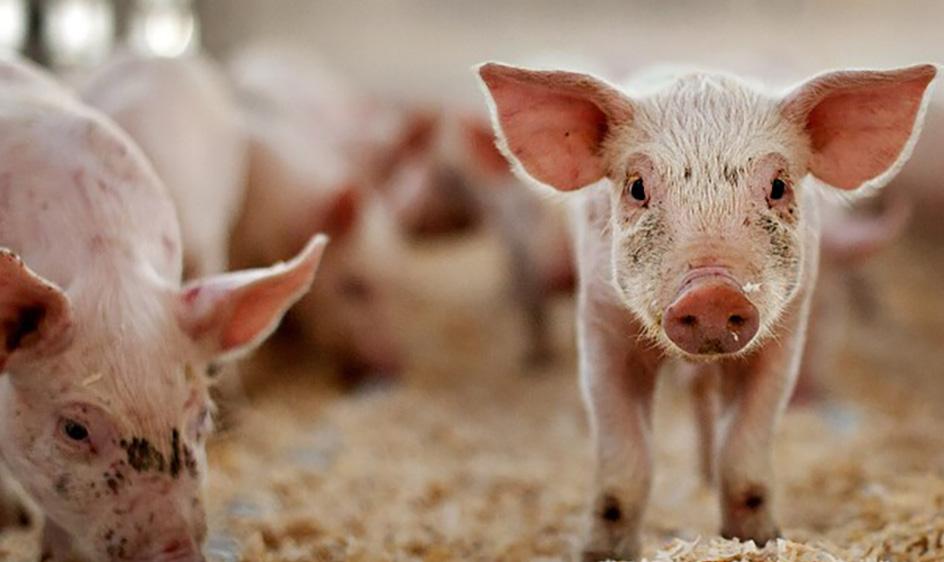
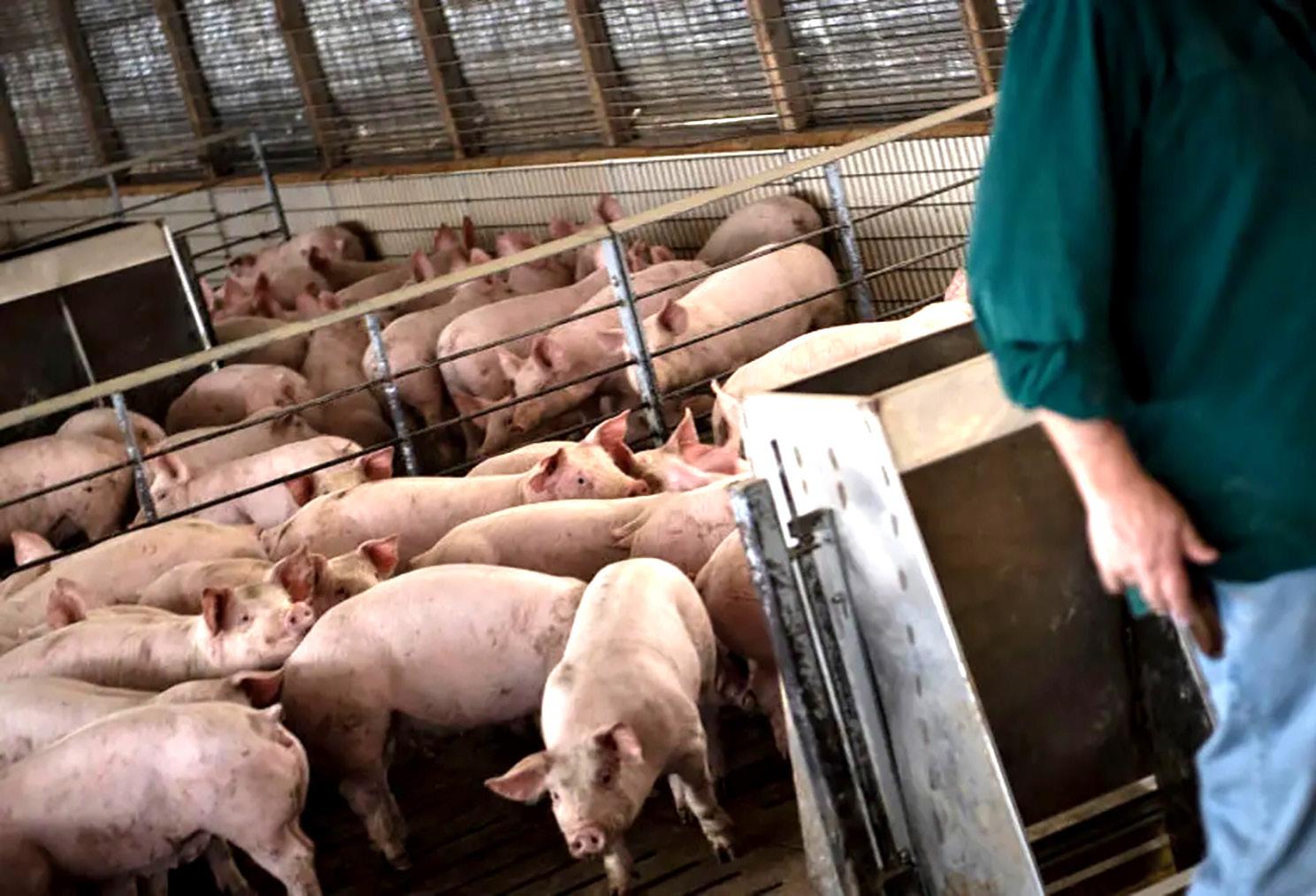
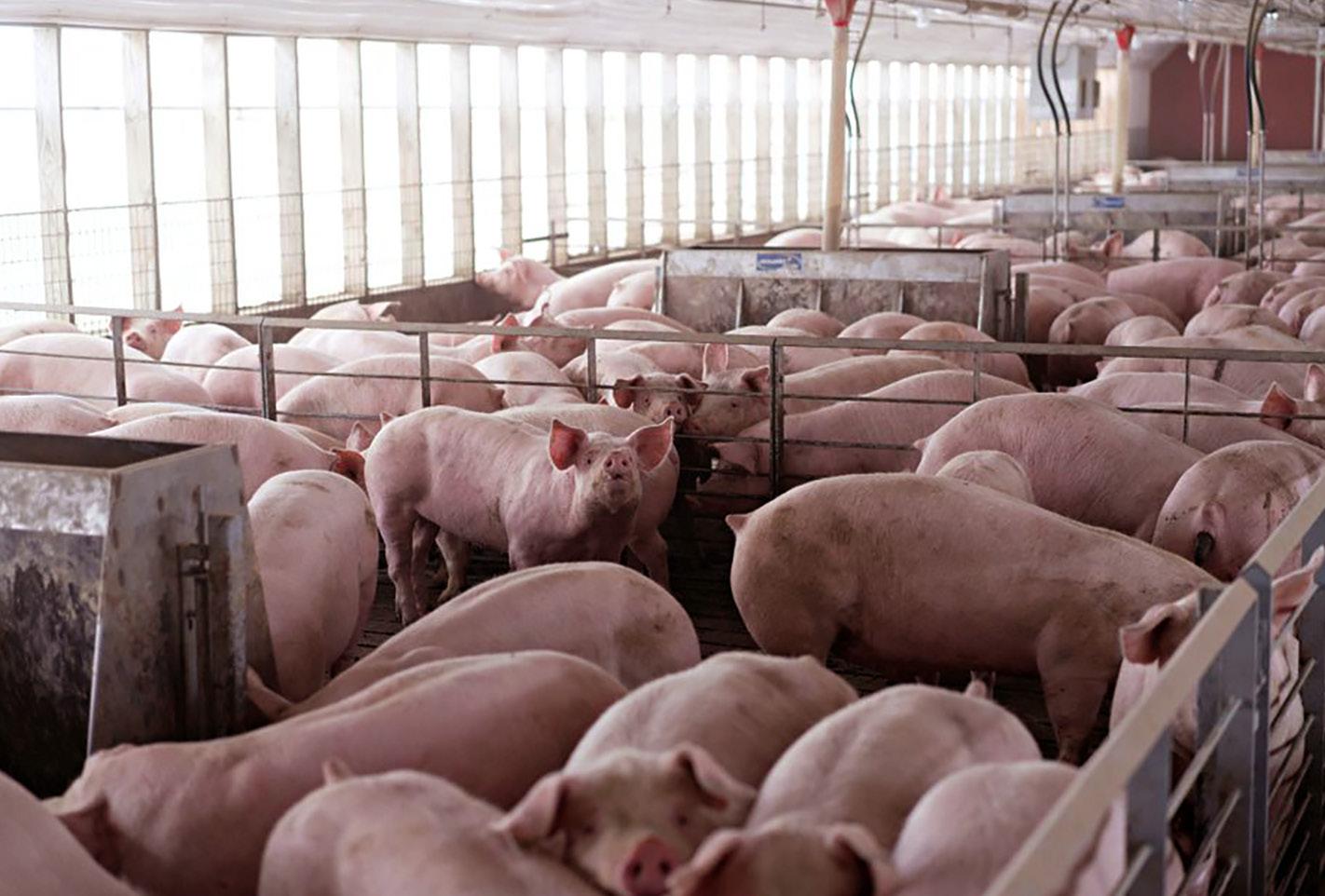
26 MEATBUSINESSPRO November 2022 meatbusinesspro.com
Some justices noted that California’s law was not regulating out-of-state farms themselves but the products sold within its own borders and questioned why the state was not allowed to do so when it also possessed the power to ban sales outright.
“As I read California’s law, it’s about products being sold in California,” conservative Justice Clarence Thomas said. “Unlike some of the cases you cite, it’s not reaching out and regulating something across state lines or regulating prices.”
Liberal Justice Sonia Sotomayor said that while California represents a huge market, “no one’s forcing them to sell to California.” Farmers could continue selling pork that did not meet California’s standards elsewhere, Sotomayor added.
But liberal Justice Kentanji Brown Jackson said that the court must accept that California’s law will have a “substantial impact on the operation of this market.” Noting that America already is divided, Kagan wondered if upholding the measure would encourage states to be “constantly at each other’s throats” by adopting laws affecting out-of-state businesses.
Conservative Justice Amy Coney Barrett asked, “Could California pass a law that said we’re not going to buy any pork from companies that don’t require all their employees to be vaccinated or corporations that don’t fund gender-affirming surgery?”
Conservative Justice Samuel Alito raised the possibility of a pork-producing state adopting regulations governing the production of agricultural products that come almost exclusively from California.
A RULING IS DUE BY THE END OF JUNE.
Animal rights groups have said some pork producers confine mother pigs in cages so small the animals cannot turn around for most of their lives. The pork industry has said the size of the cages used at pig farms are humane and necessary for animal safety.
Proposition 12 set the required space for breeding pigs, or sows, at 24 square feet (2.2 square meters). The current industry standard is between 14 and 20 square feet (1.3 to 1.9 square meters), according to a 2021 report from Dutch banking and financial services company Rabobank.


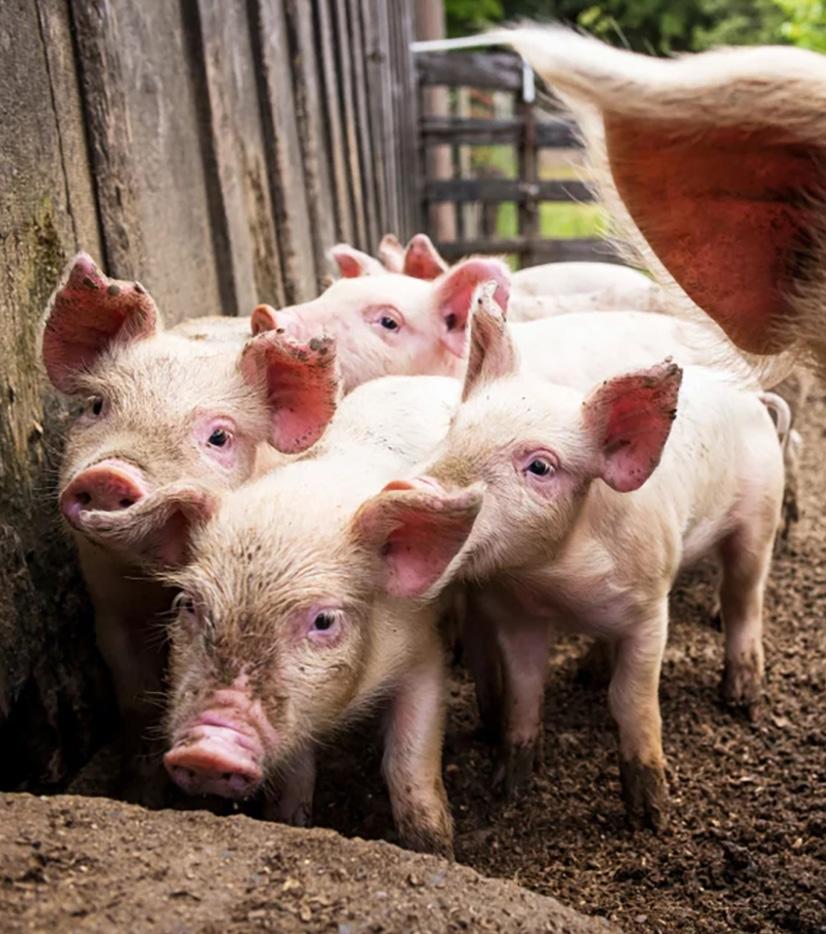
The Supreme Court took up the case after the San Francisco-based 9th U.S. Circuit Court of Appeals affirmed a district court’s decision to throw out the lawsuit.
President Joe Biden’s administration has sided with the pork producers, saying that states cannot ban products that pose no threat to public health or safety due to philosophical objections.
27 meatbusinesspro.com November 2022 MEATBUSINESSPRO

https://www.yesgroup.ca meatbusinesspro.com






























 By Martha Roberts, Economic Editor, Farm Credit Canada
By Martha Roberts, Economic Editor, Farm Credit Canada











































































